In the last couple of years, I know of a number of people who’ve been to Turkey and come back with incredible stories. But though it’s been on my bucket list for a while, it wasn’t the first place we thought of visiting while vaguely talking about a holiday somewhere in Europe for the summer. It turns out, a valid US visa on Indian passports means that you just need to get a very quick e-visa for Turkey. That, along with cheaper flights than to any other European destination finally did it and on a whim, we booked tickets.
And oh my god, I’m so glad we did! We chose to visit Istanbul and the Cappadocia region and both were so much more and so completely different from what we’d expected. There’s a whole load of things to do, see, eat and experience and I can’t wait to tell you more. Warning: this is a long post!
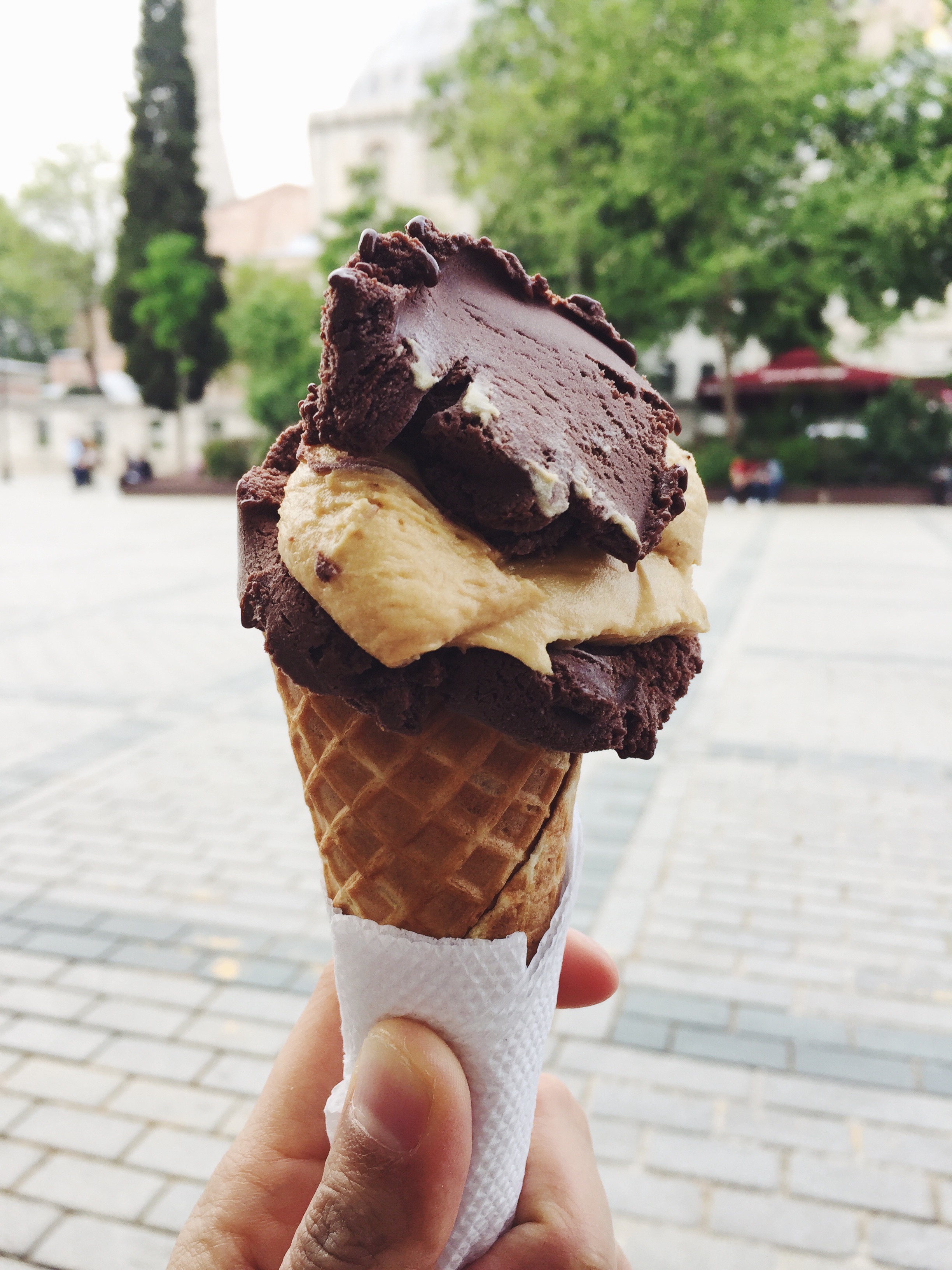 We flew into Istanbul from Mumbai, stayed one night and then flew to Kayseri and from there, drove to Goreme in Cappadocia (spelt Kapadokya the original Turkish way). After two nights there, we came back to Istanbul for three nights and then headed home. It sounds rushed, and in parts, it was. But we covered a lot of ground, much of it on foot, and it was worth the aching muscles! I’ll divide this post up into two main parts and give you as much detail as possible. We had such good luck with our Airbnbs that I’ve linked back to them in the post as well. I’ll talk about the food right at the end because I’m a vegetarian and my experience was different from most tourists in Turkey. I also saved a lot more photos to my Instagram Story Highlights if you want to check them out. Feel free to ask questions below 🙂
We flew into Istanbul from Mumbai, stayed one night and then flew to Kayseri and from there, drove to Goreme in Cappadocia (spelt Kapadokya the original Turkish way). After two nights there, we came back to Istanbul for three nights and then headed home. It sounds rushed, and in parts, it was. But we covered a lot of ground, much of it on foot, and it was worth the aching muscles! I’ll divide this post up into two main parts and give you as much detail as possible. We had such good luck with our Airbnbs that I’ve linked back to them in the post as well. I’ll talk about the food right at the end because I’m a vegetarian and my experience was different from most tourists in Turkey. I also saved a lot more photos to my Instagram Story Highlights if you want to check them out. Feel free to ask questions below 🙂
Istanbul
Everyone I spoke to warned me that Istanbul is such a large city, you need a week to see it properly, maybe even more. We had four and a half days and so the smartest thing to do with fewer days, is pick what you want to see, rather than try and work your way down a huge laundry list that honestly just makes sightseeing exhausting. The city also has such a rich history, spanning the Roman, Ottoman and Byzantine empires, that it’s a good idea to read a bit about it, so you can appreciate what you see over there.
 Istanbul has an Asian side, and European side divided by the huge Bosporous River. Within the European side, two big districts called Sultanahmet (which is where the main tourist destinations like the Blue Mosque and Hagia Sophia are) and Karakoy are connected by a small bridge. The differences between the two sides of the city in architecture, culture, even just daily life are quite apparent. We found it fascinating to see just how big of a melting pot this city can be, so much like Mumbai!
Istanbul has an Asian side, and European side divided by the huge Bosporous River. Within the European side, two big districts called Sultanahmet (which is where the main tourist destinations like the Blue Mosque and Hagia Sophia are) and Karakoy are connected by a small bridge. The differences between the two sides of the city in architecture, culture, even just daily life are quite apparent. We found it fascinating to see just how big of a melting pot this city can be, so much like Mumbai!
Our first night, we stayed in a very conveniently located guesthouse in Sultanahmet and made our way to the Blue Mosque the day we reached, half asleep after having flown all night. There was some restoration work on at the time, so only a small area was open to visitors. That, combined with the sheer number of people on a weekend sort of dilutes the experience but on a weekday, it’ll be a lot better. That’s why we left Hagia Sophia (pronounced Ayasofya) for after we returned to the city from Cappadocia. On a relaxed Thursday morning, there were no long queues and not as many tourists so it was easy to appreciate this beautiful monument that was once a cathedral, and then a mosque and now a museum. The overlaps between the two religions and cultures are so fascinating, you absolutely must not miss this!
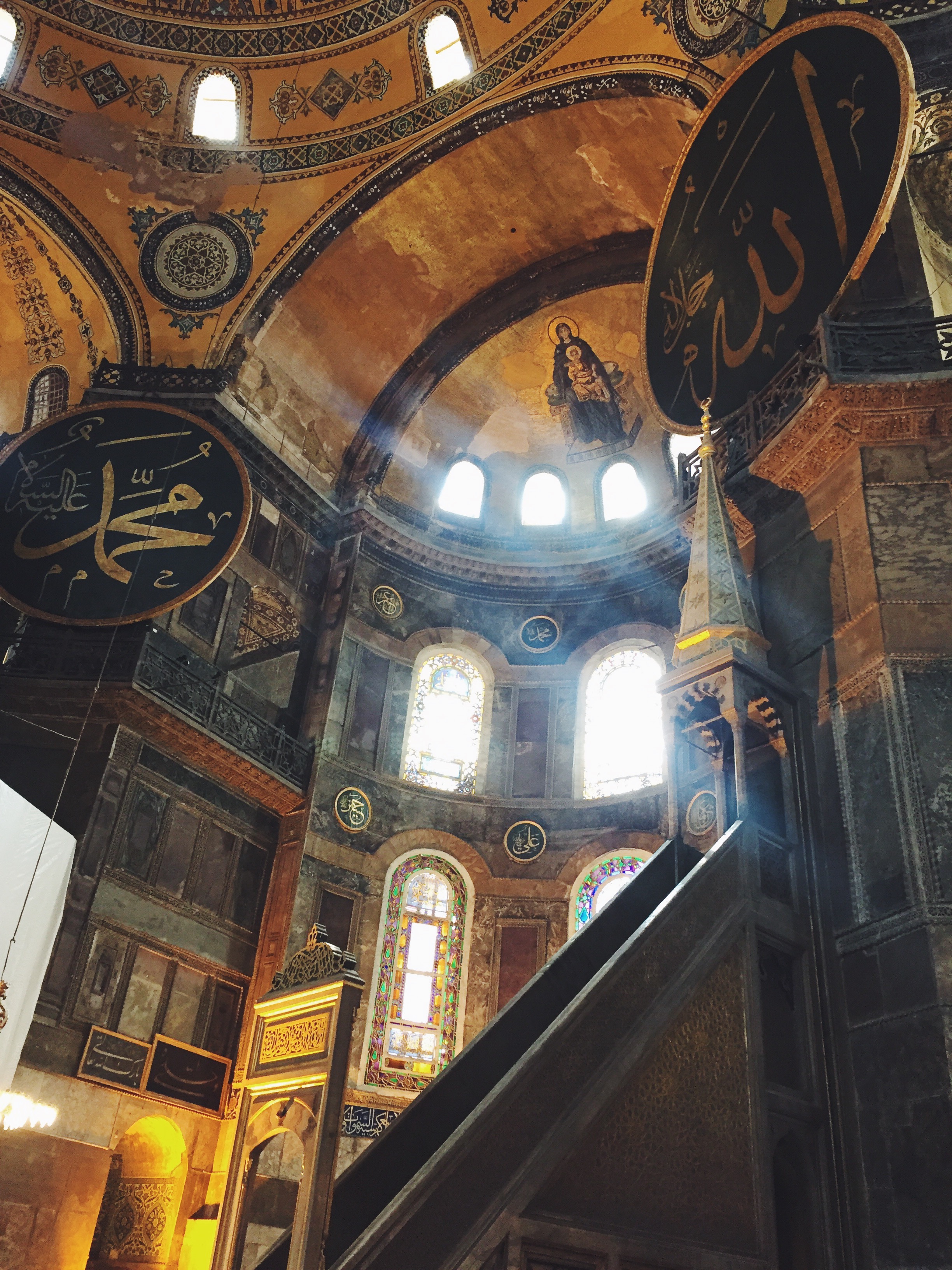

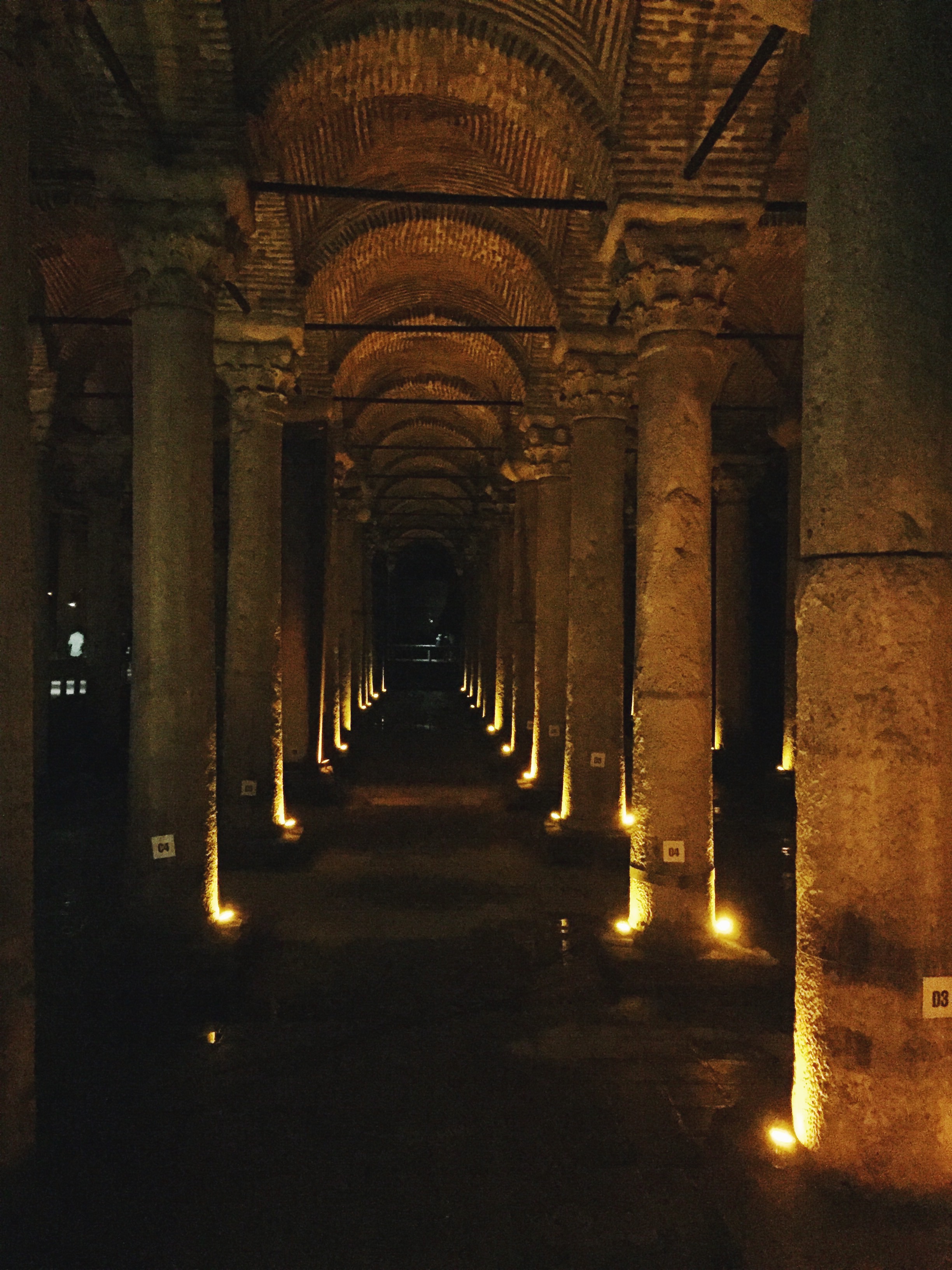
Also make a stop at the Basilica Cistern (above) which is stunning inside, while being kind of spooky. It used to be the city’s water supply source, and is built in the most unexpectedly beautiful way.
While Sultanahmet is the most tourist-concentrated area, it is also filled with pretty streets, lots of restaurants, cafes and shops. Everything is clean, well-organised and generally very nice to walk around and spend a morning even if you’re not doing a ton of sightseeing. There’s tons of small hotels, guesthouses and BnBs to choose from as well.

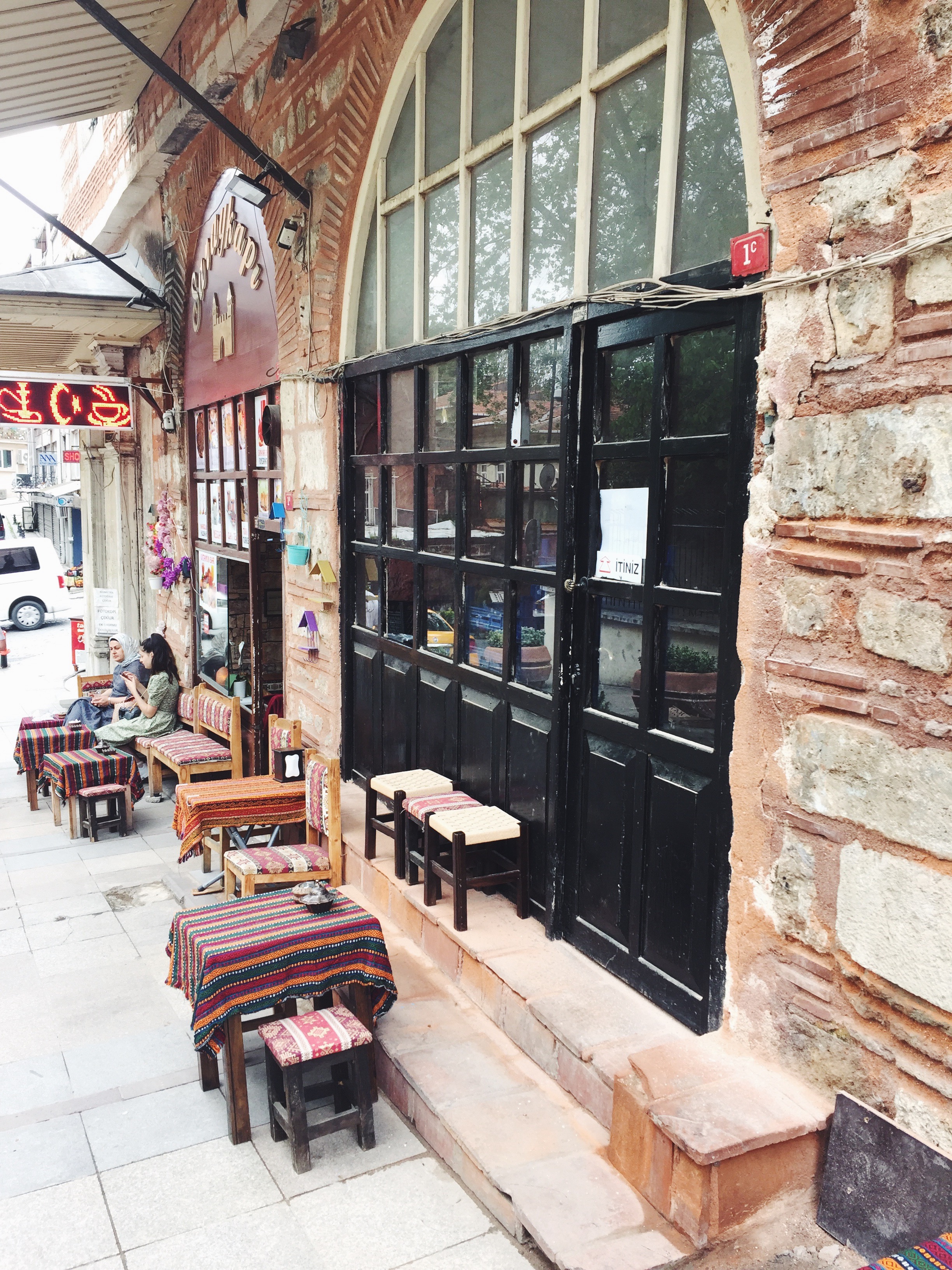
You could also head to Grand Bazaar, although we didn’t enjoy this much because unless you plan to do a lot of shopping, or don’t really see big markets often, there isn’t a lot to do there. There are a ton of ceramic shops if you want to pick up some colourful plates and bowls, or even some of Istanbul’s famous sweets (although it’s best to buy them fresh, not pre-packaged. More on that later!).
Also on the European side is the Dolmabahce Palace which is STUNNING. If there’s only one thing you see in Istanbul, this should be it. In the late 1800s and early 1900s this palace was occupied by various Sultans at different times in the city’s history. Photography isn’t allowed inside which is GREAT because you don’t keep bumping into selfie-takers every two seconds. It also has a lovely cafe by the Bosporous river and if you go on a sunny day, the palace grounds are just spectacular. Seriously, I was ready to go back there the next day!
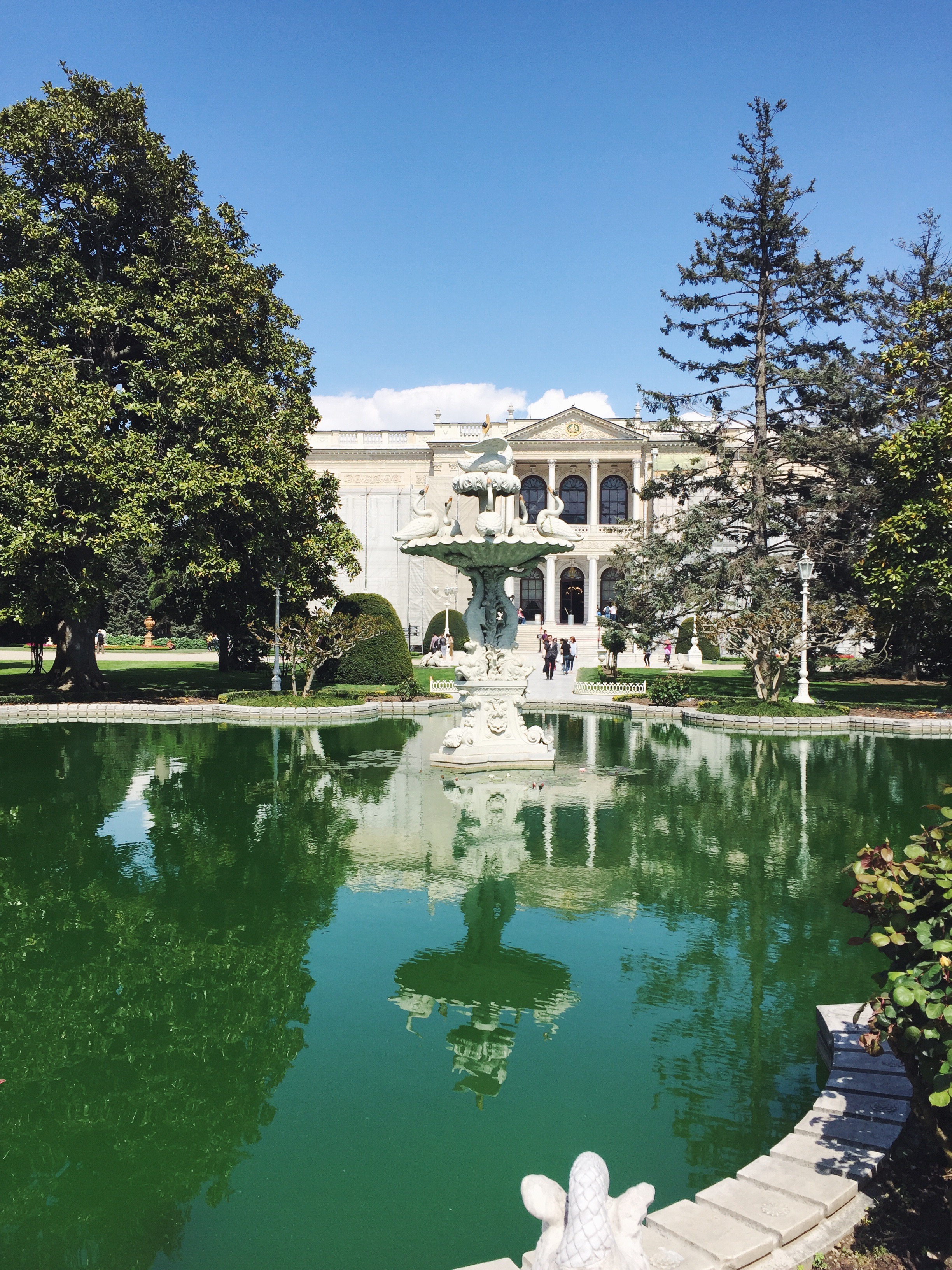
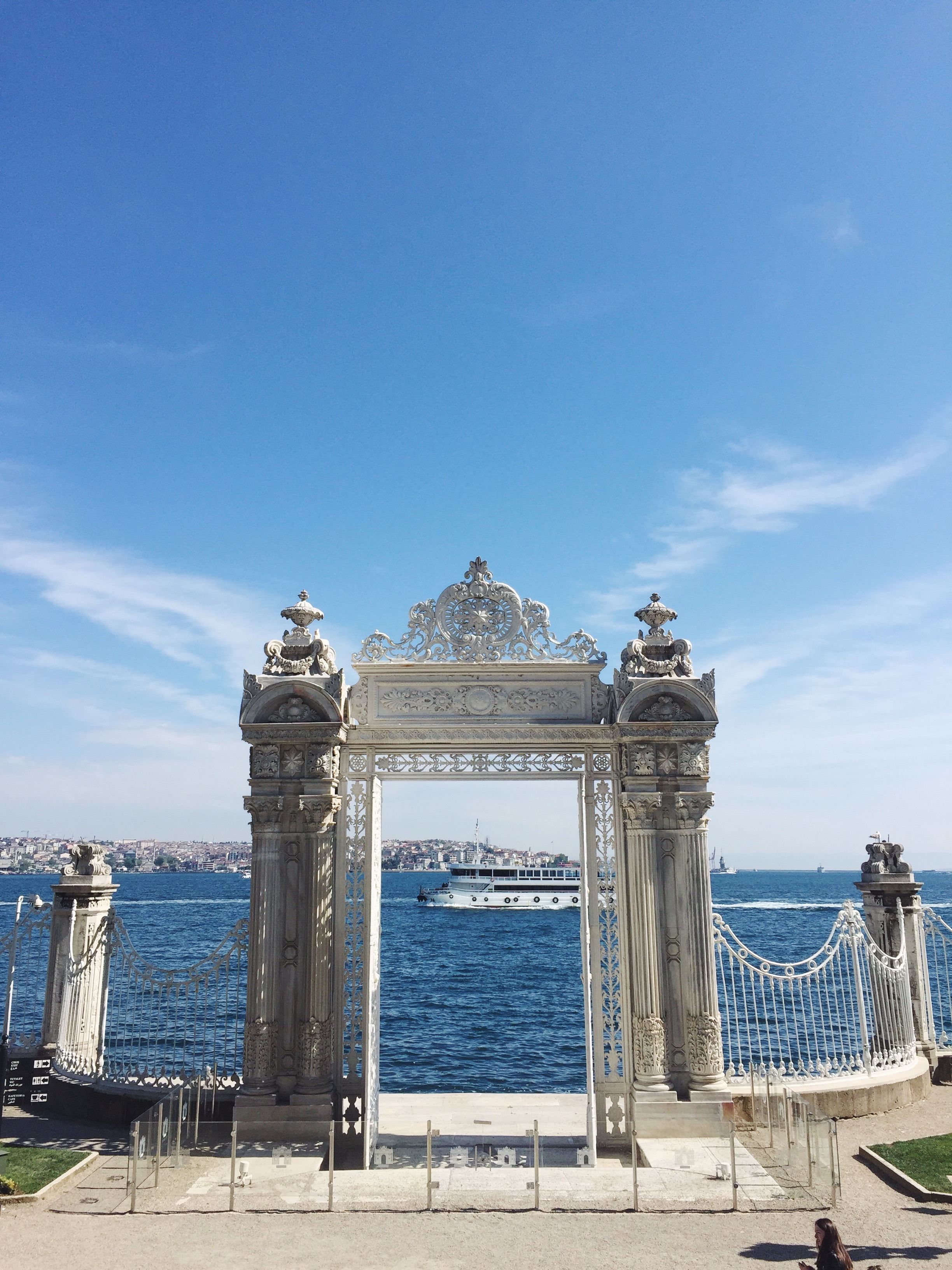
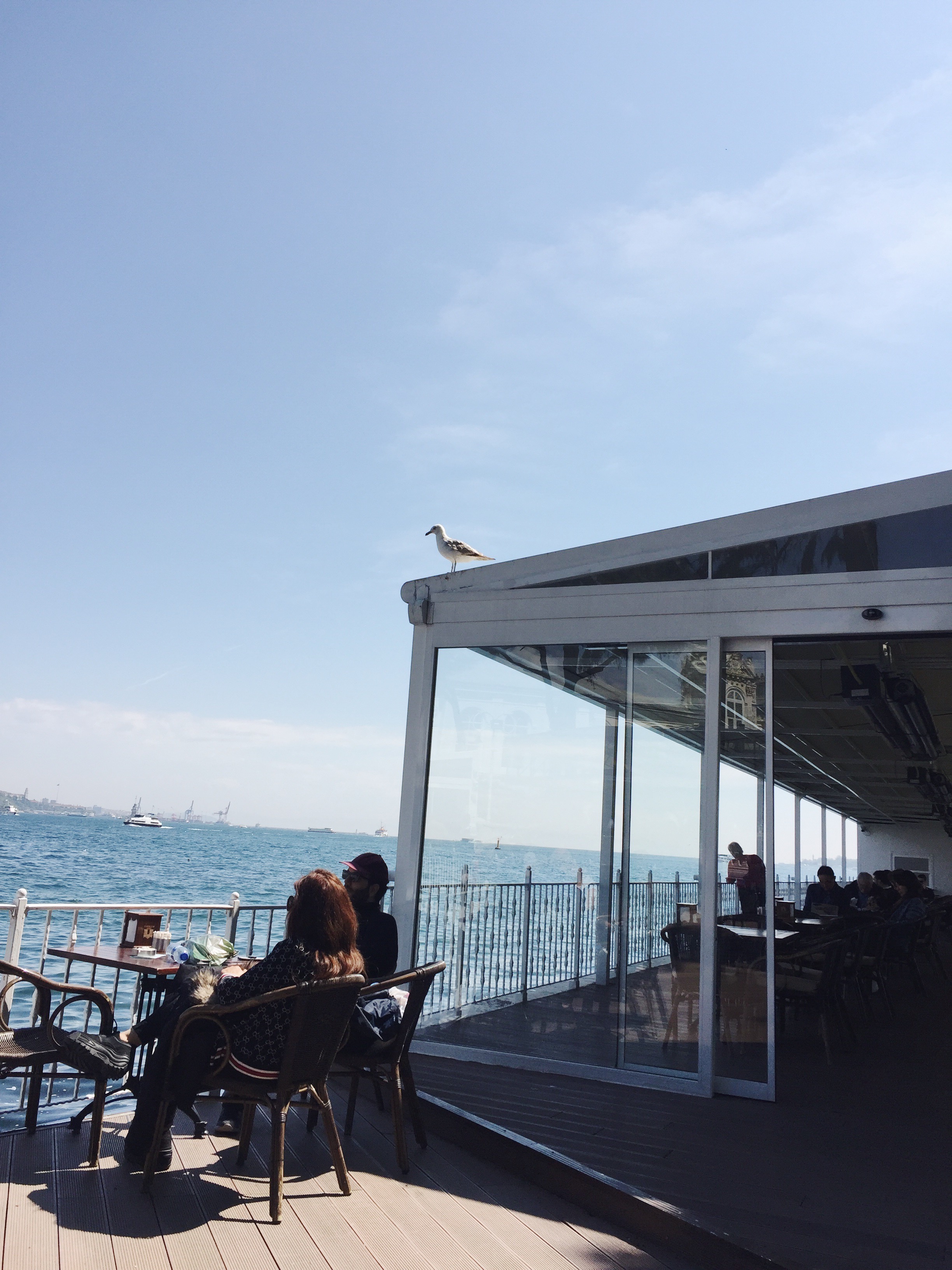
Later in the week, we took a ferry over to the Asian side and it stops at Kadikoy. There isn’t however a lot to do this side, so my advice would be to stick to the European sides of Sultanahmet and Karakoy especially if you’re short on time. If you do go, there’s the old Haydarpasha railway station that is being restored but the restaurant there is still open and it’s quite a fascinating local haunt. You could also take one of the bigger Bosporous River Cruises that takes almost a full day, so if you have the time, I’ve heard the daytime tours are worth it, although we decided not to add to our list!
In the second half of our stay in Istanbul, we headed across to the other part of the European side, to stay in the Karakoy – Beyoglu area which are considered the coolest, most contemporary parts of the city. It’s easy to see why! Narrow streets full of cafes, restaurants serving all kinds of cuisines, souvenir shops that do their best to break away from the traditional ones, lots of locals enjoying all of it as much as the tourists and of course, the famous Galata Tower which has some seriously stunning views of the whole city (second picture in this post). Our favourite thing to do here was walk everywhere. We also visited the Istanbul Modern, a contemporary range of art exhibitions that are definitely worth a visit. It’s a nice break from more typical sightseeing and there’s something for everyone in the exhibits.
The city is well connected by metros, trams and buses, in case you get tired of walking, but keep in mind that it’s unavoidable to an extent. Buy the Istanbul Kart at the airport when you land, and it makes it much easier to swipe in different forms of transport, instead of having to buy tickets each time. You can refill it with money as needed at any of the machines at bus stops, airports or train stations. While walking, remember that there are steep roads and hilly portions even in the city, so good shoes are a must, as boring as that sounds. Keep in mind that most smaller hotels, bnbs and guesthouses don’t have elevators and staircases are usually narrow, so keep your baggage as light as possible!
The main street most tourists here head to is Istiklal. It’s HUGE and packed with places to eat and shop at. While vegetarian food isn’t hard to come by, I didn’t find a lot of variety (more at the end of this post). But on this street, I came across falafel shops and something incredible called Kumpir which is a baked, mashed potato with pretty much any toppings you can think of! The street is nicer in the day, when there are fewer people and therefore, everything is less crowded. This entire district is definitely more consciously designed to attract tourists, but it’s still very charming.
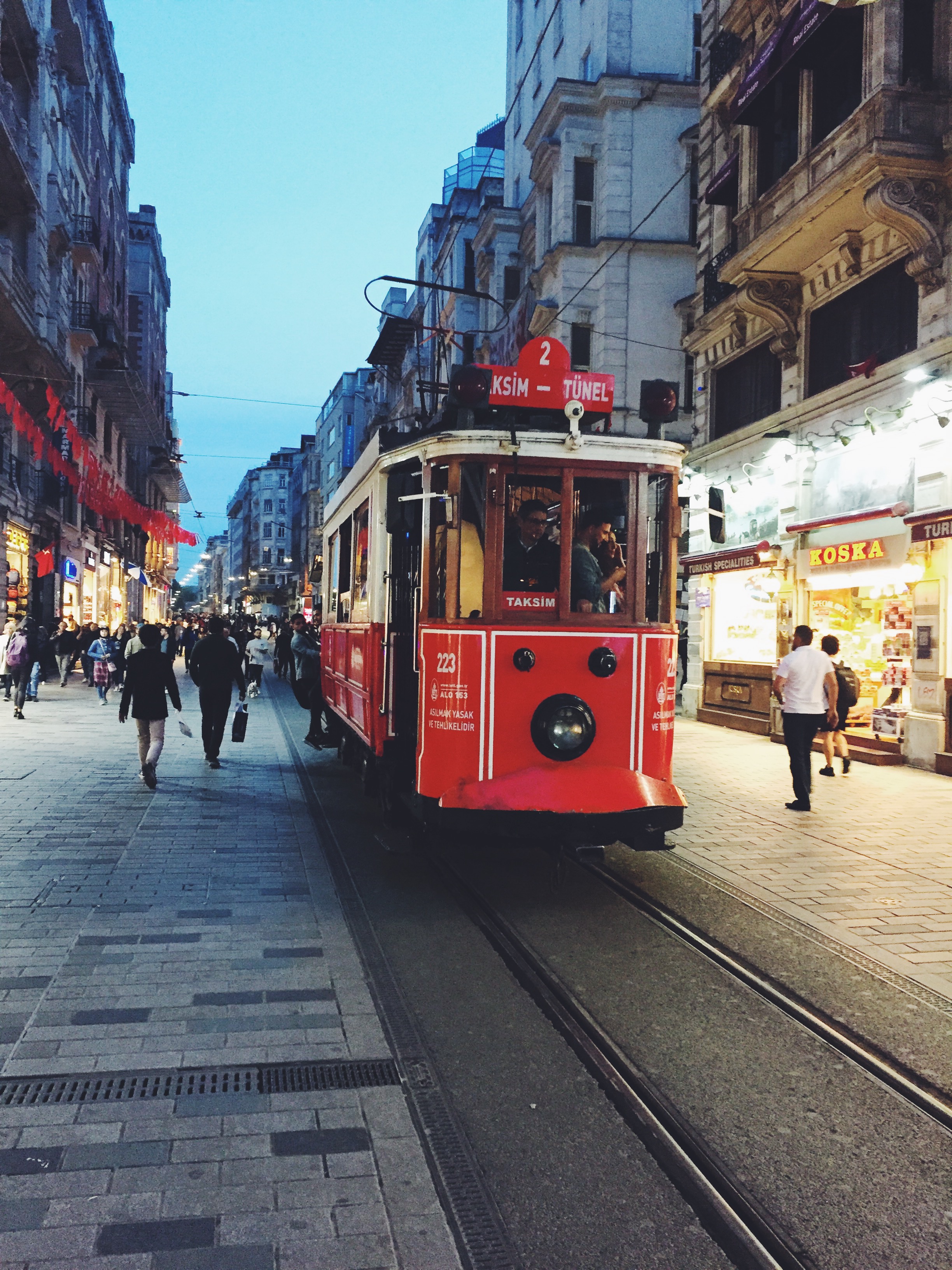
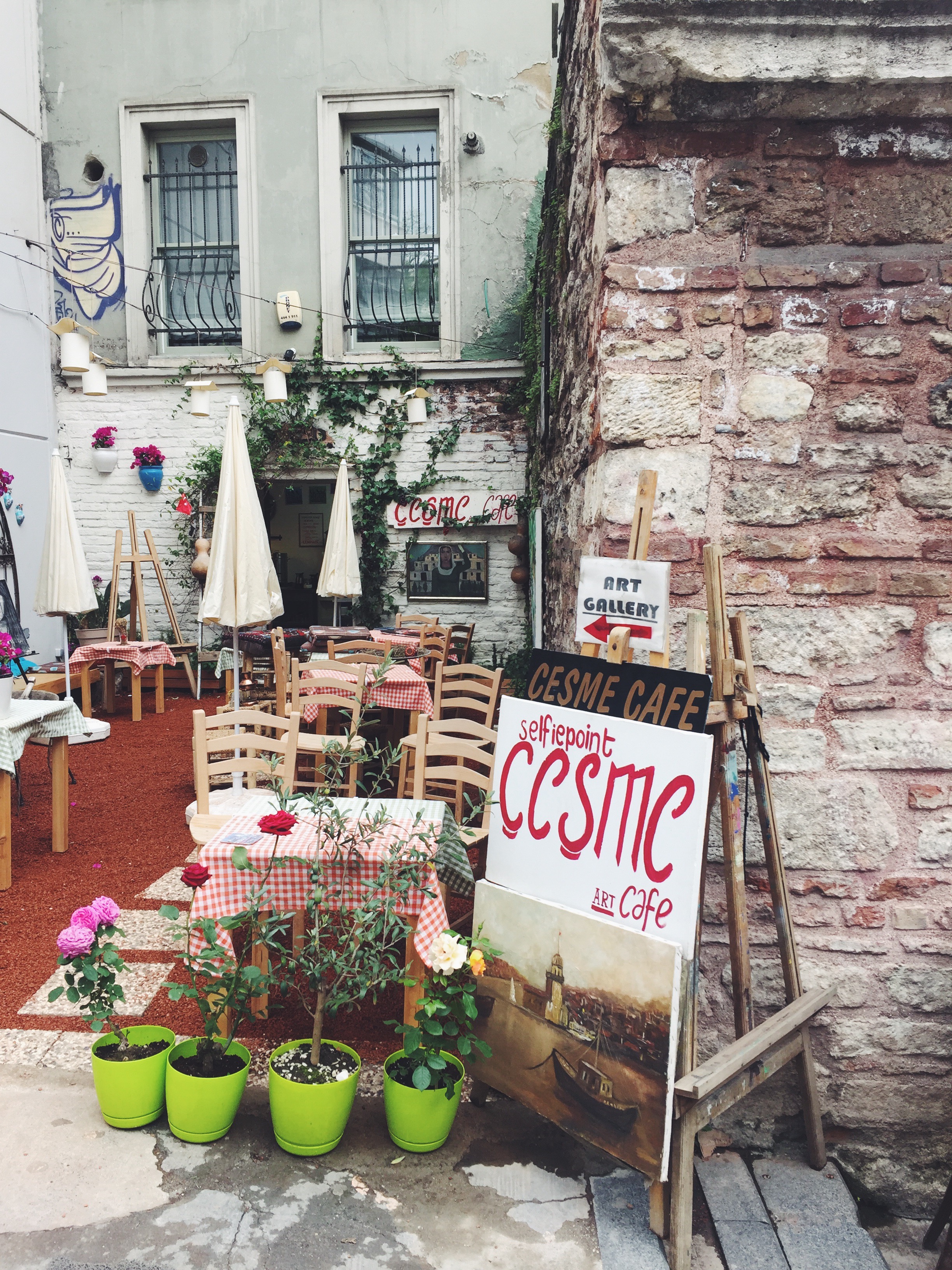
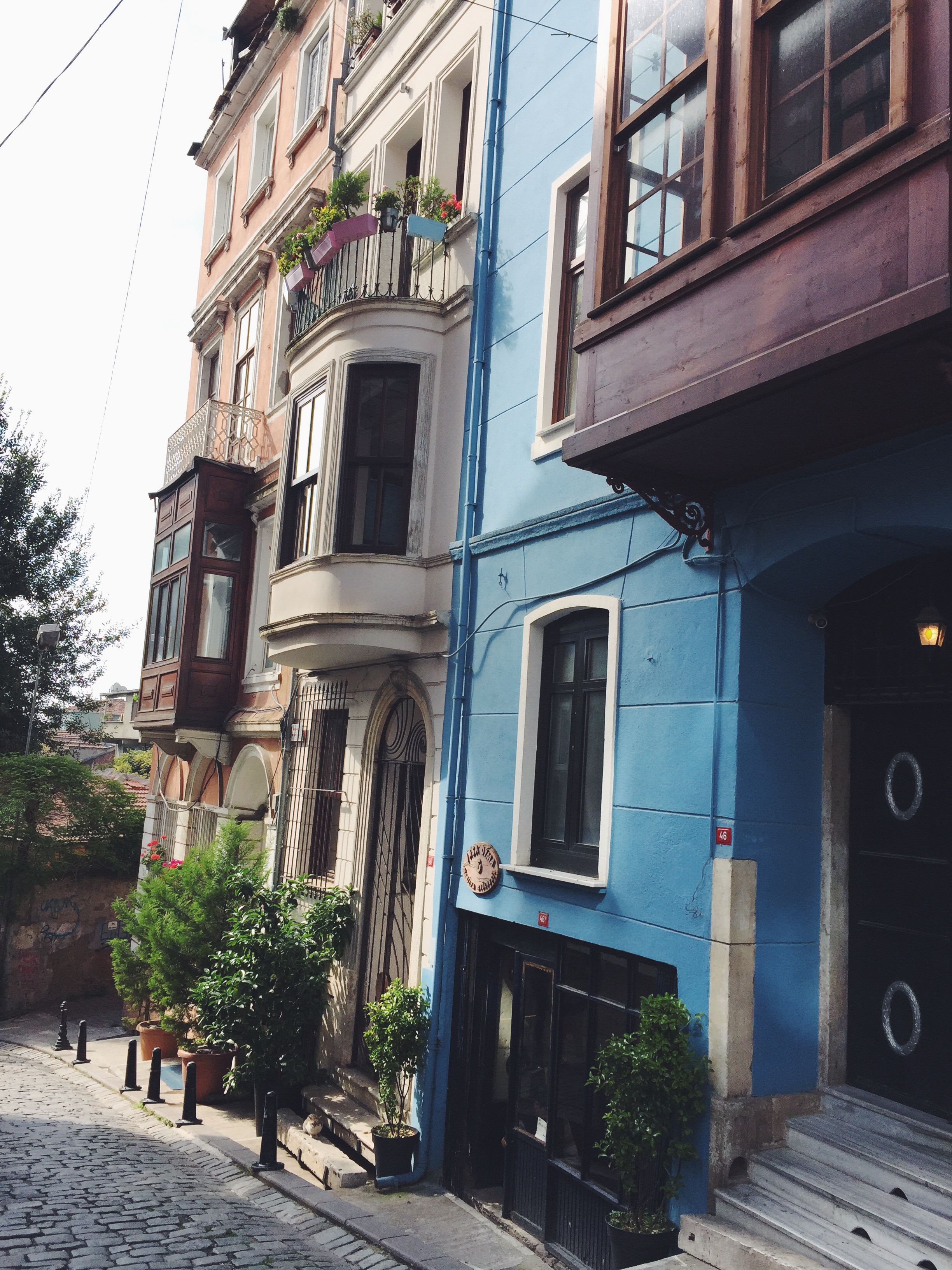
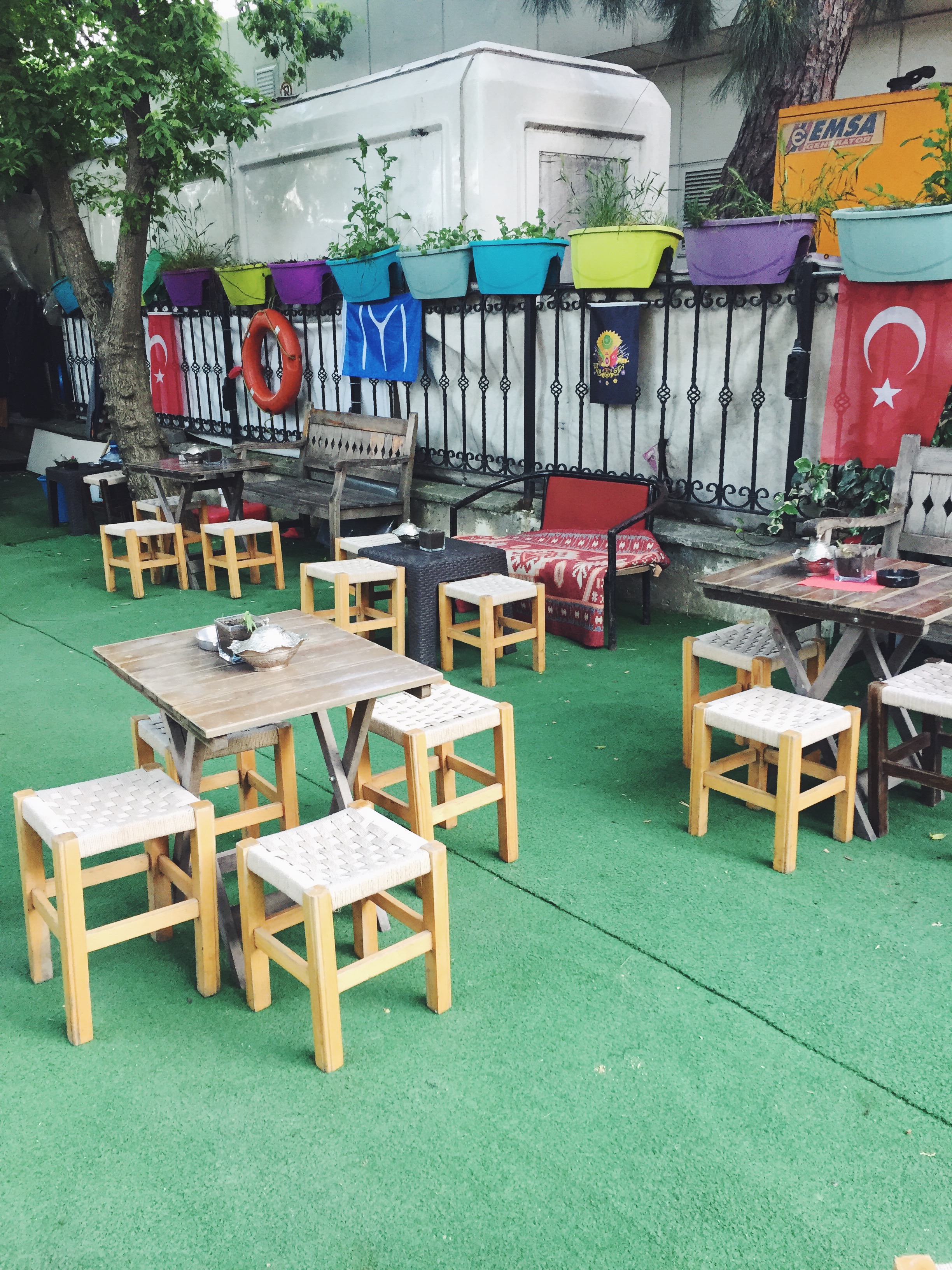
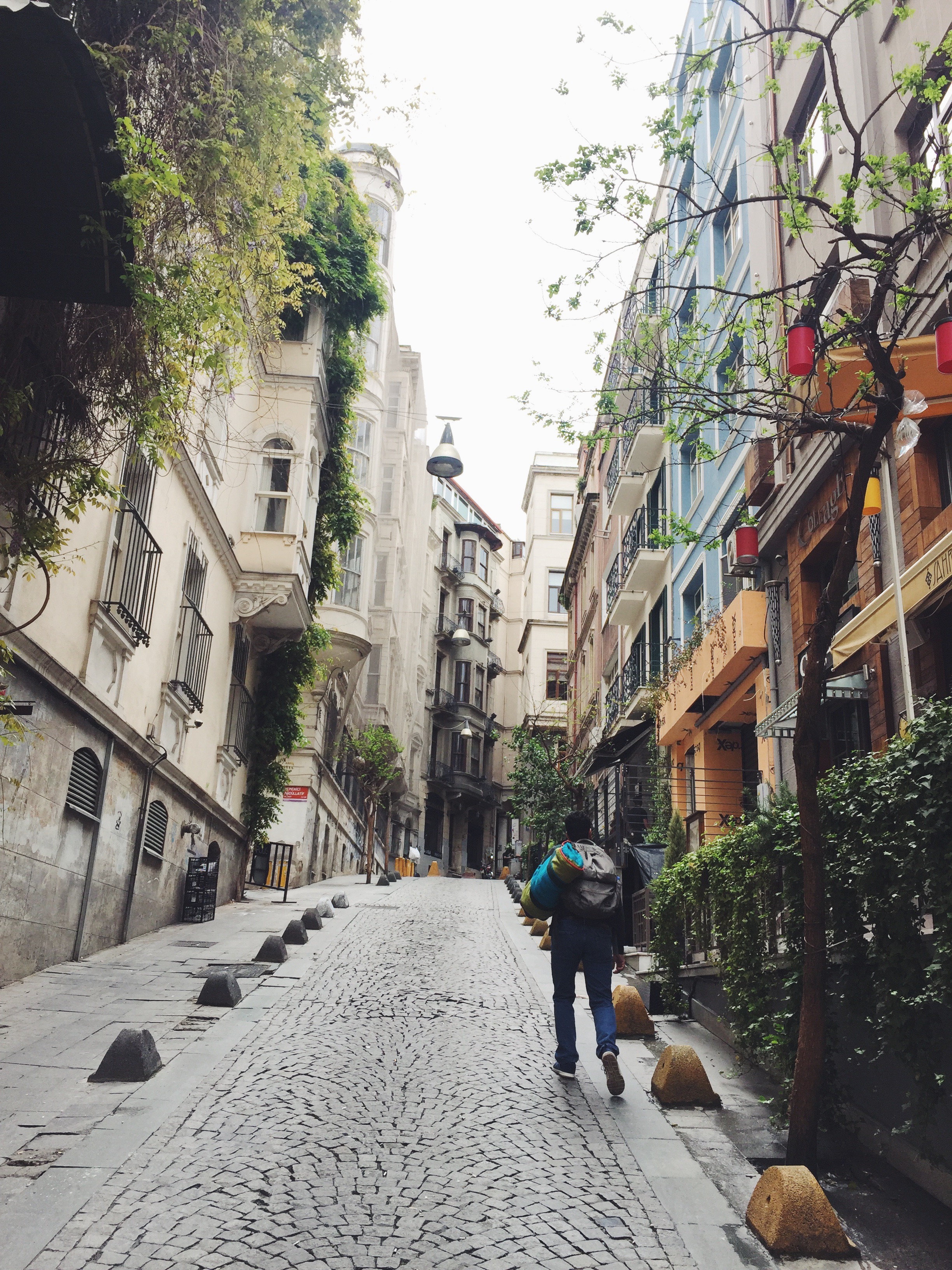
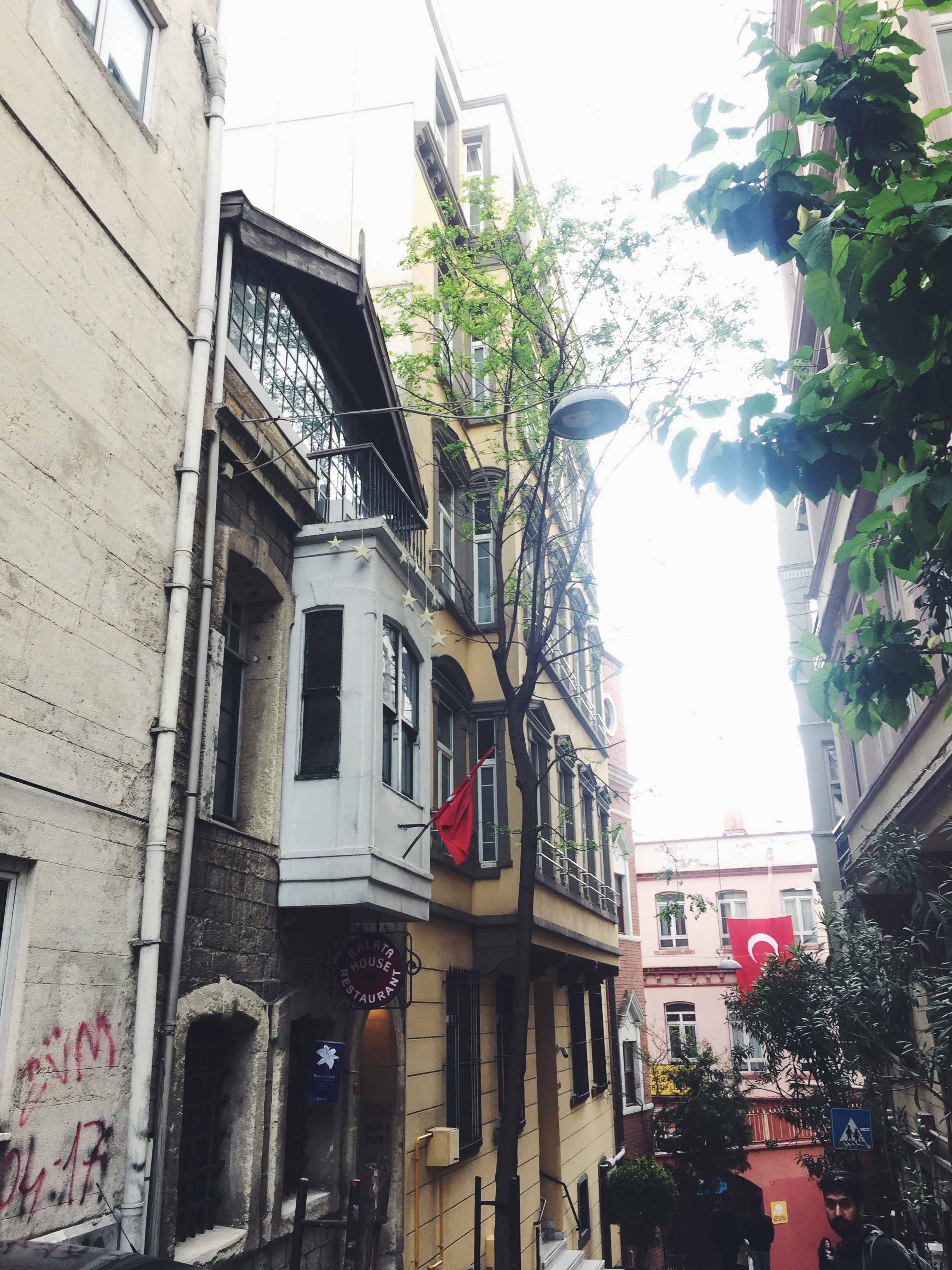
Within the city, you will come across a few people who may not speak English, but they are always super helpful anyway. We even had a couple of them use Google Translate to give us directions or to understand what we were asking. It was so so nice of them! I was surprised by how many words were in fact similar to Hindi. Their lentil soup is called ‘corba’, like the Hindi ‘shorba’. A bill at a restaurant is called ‘hisaab’ and ‘cash’ is ‘nakit’, like the Hindi word ‘nakad’. You live and learn!
Istanbul really was so much more than I expected. We were there around the time that Ramadan started and wondered if certain restaurants will be closed or if our experience there would be different from another time in the year. But nothing of the sort happened and life continued as normal. Even the weather was perfect, at about 15 C, not too cold, but just cold enough to forget the sauna that Mumbai is right now!
And now on to the other part 🙂
Goreme, Cappadocia
This was the middle of our trip, bookended by Istanbul on either side. You can definitely choose to fly straight to Kayseri airport from Istanbul’s main international airport and head to Cappadocia directly, but we decided to break journey. The reason is that getting to Cappadocia is a whole day’s affair so it becomes a bit taxing to do that immediately after flying into Turkey from another country. The internal flight is just about an hour, but both domestic airports are also an hour away from the main city/town areas. Make sure you ask your hotel or Airbnb host to prebook you on an airport shuttle from Kayseri to Goreme, which is the town most tourists in Cappdocia head to. Once you land, the shuttle will be waiting and you’ll have a lovely drive through the region.
Cappadocia is famous for its unreal landscape of ‘fairy chimneys‘, which are natural rock formations that were used as homes hundreds of years ago. The region is also known for its hot air balloon rides but unfortunately ours were cancelled due to the cloudy weather despite the last minute reservations we got. I do have a fear of heights though, so I’m pretty sure I would have screamed the roof (sky?) down!
Once here, there are two things to do. Explore the landscape as much as you and then enjoy the town of Goreme, which has more cafes and shops than I ever imagined. Again, it is touristy, but not overwhelmingly so, especially in May which is still the beginning of peak season. Most hotels offer the same kind of tours and sightseeing opportunities, so it’s best to go through them.
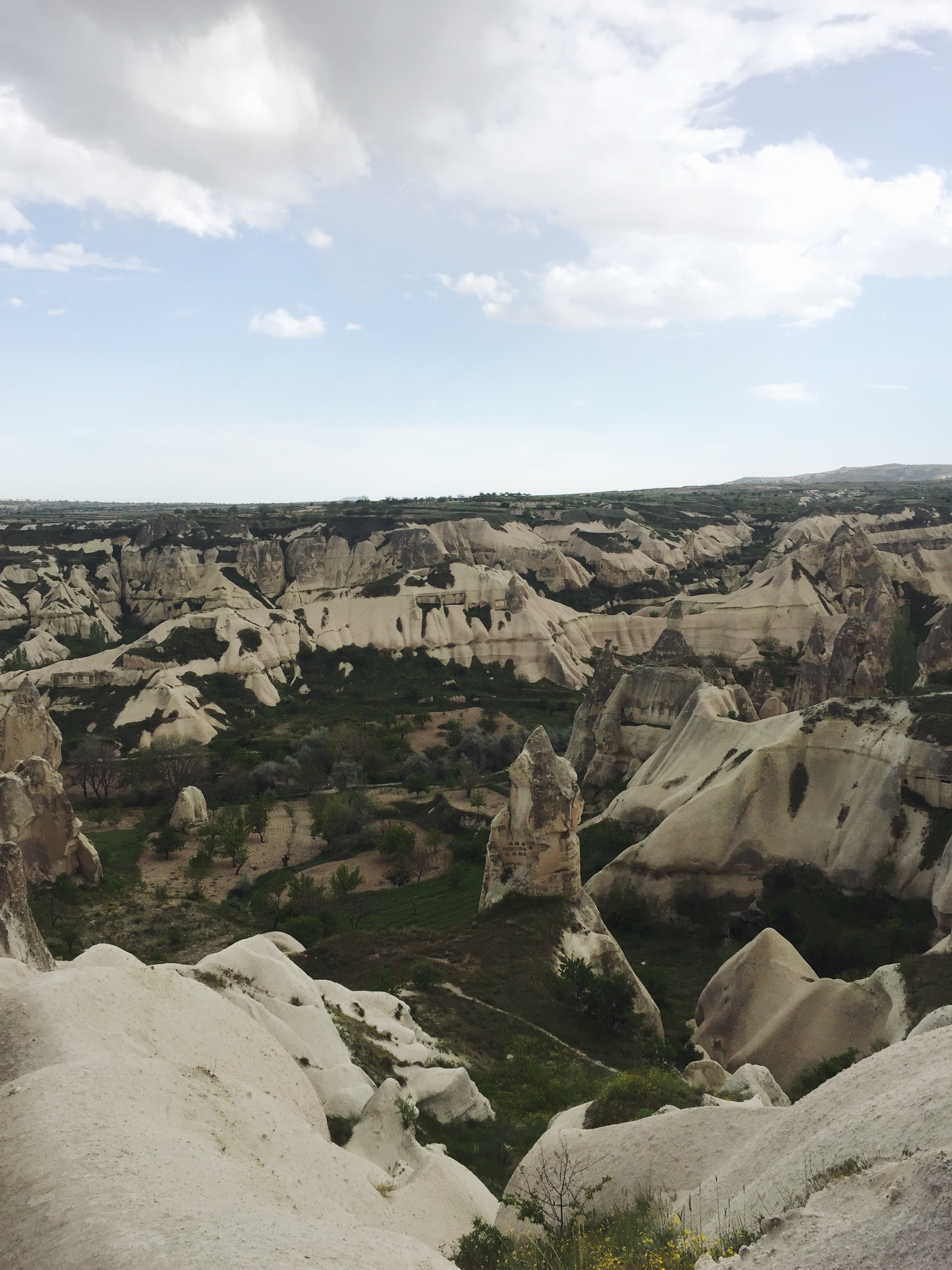
There are three main tours offered: Red, Green and Blue. Each takes you on a different day-long tour of nearby provinces. We chose the Green Tour, got picked up and dropped at the hotel, with a nice lunch (with vegetarian options) included. The tour took us to one of the fascinating underground cities of Cappadocia, the Selime Cathedral which is a lovely climb and was one of the first cathedrals here, constructed by the earliest Christians in Turkey. It does not look like a traditional cathedral, but there are frescoes on the rock and plenty of indicators of what was once such an important house of worship. The longest walk/hike/climb was through the beautiful Ilhara Valley and though my leg muscles were screaming by the end of it, it was so worth it. There’s a cute little riverside tea shop halfway down and you must stop there for a breather and take in the landscape. Again, good shoes are a must! And hydrate lots, it’s easy to forget to drink water because the humidity is so low, thirst takes a while to make its presence felt. Basically, this was a lovely day and we’re very glad we took this tour, because a guided tour isn’t something we really do too often. It’s well organised, the guide is usually informative, humourous and accommodating.
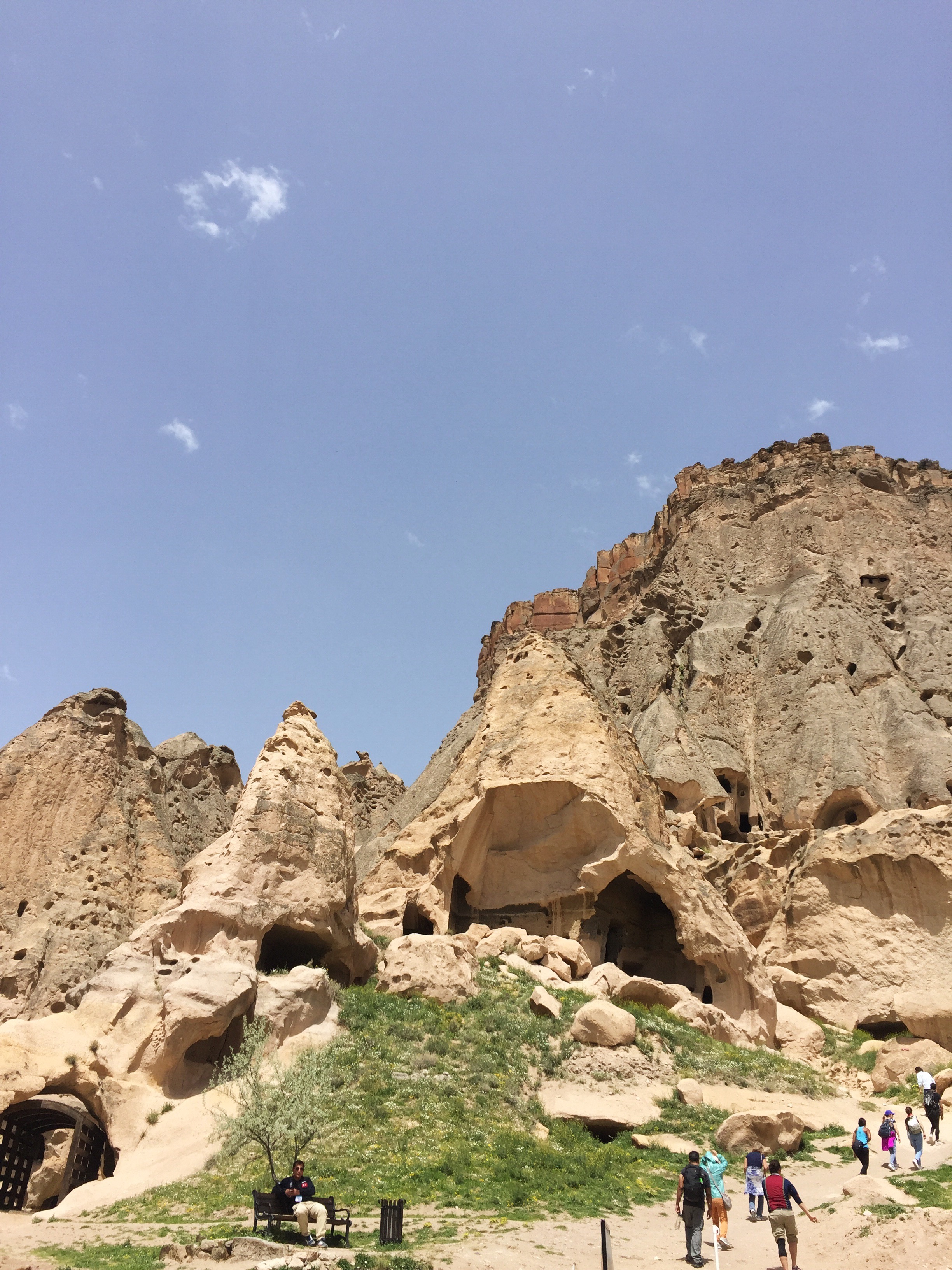

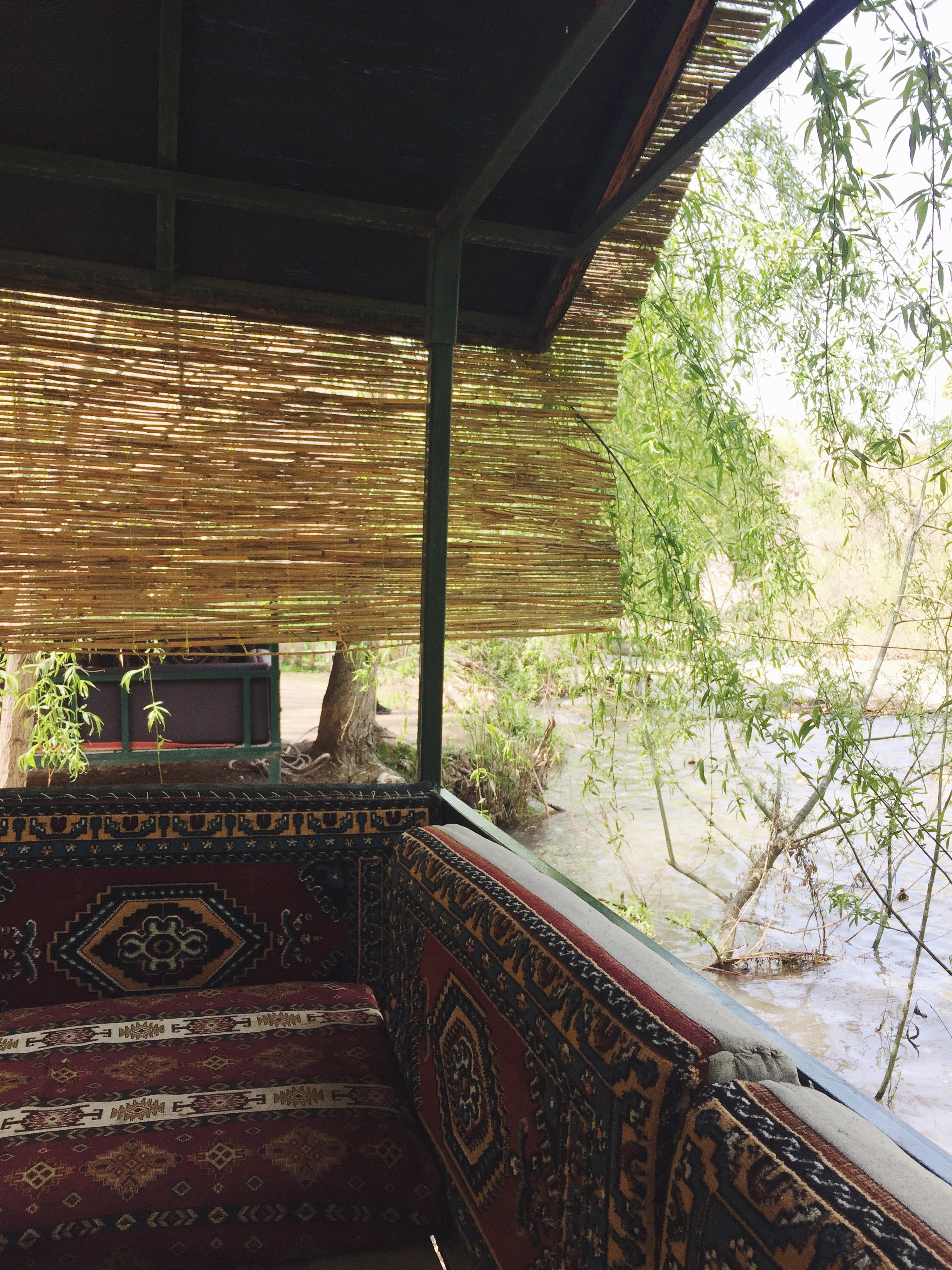
To stay, definitely choose a cave hotel because that’s half the experience. Literally carved into caves, the rooms are cute, cosy and done up with Turkish decor. Most places serve breakfast as well and it’s fun to sit down and take in the views or get to know the others staying at the hotel, and most importantly, the staff because they’re full of information, lovely to talk to and are always ready to help.
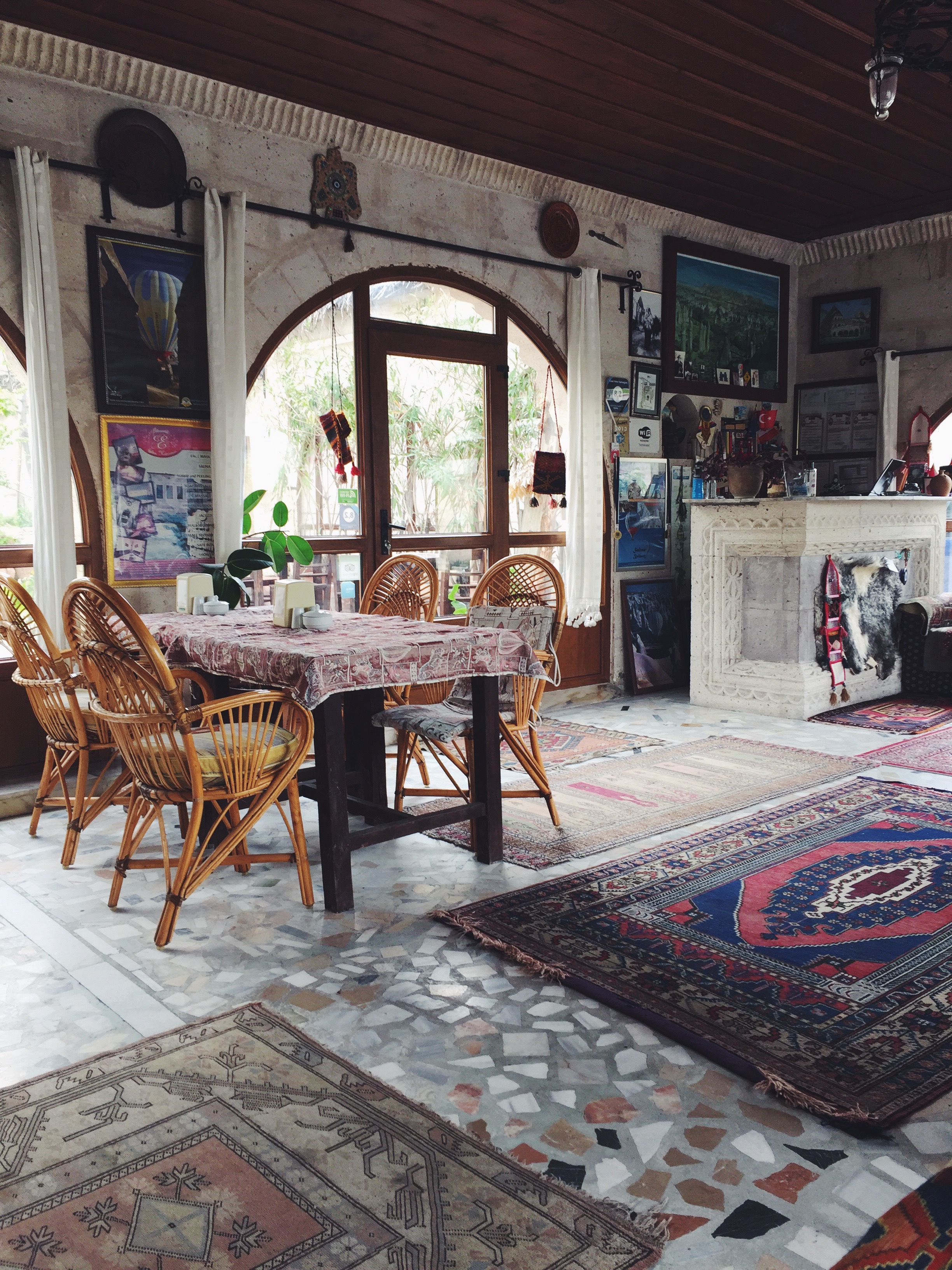
If it’s your first time in Turkey, Cappadocia is very highly recommended. You need about two days here, not much more than that because if you overdo the sightseeing, all of it starts to look the same. Choose one tour that sounds good to you and if you’re lucky, you may get to do the hot air balloon ride! Take time out to chill at one of their rooftop cafes also, it’s quite an experience and the views are lovely.
And now, the foooood!
What to eat, especially if you’re a vegetarian
Turkish food is meat intensive, and I’ve heard it’s got among the best kebabs and doners in the world. The use of spices in all the food is mild, which surprised me a little, but it’s still delicious. I eat eggs, but no meat and I have seafood intolerances so if I accidentally eat something with say, fish sauce, I’m out of commission for a few days! Which is why if I’m travelling outside India, I’m very very careful because I’ve learned the hard way that it’s best to be a little paranoid.
So, in Turkey, vegetarian food is not hard to find like I said above, and nor is there any grey area about the ingredients, but in the most touristy areas, there are some standard options to choose from. Look out for pide pizzas which are easily vegetarian, gozleme which is like an Indian stuffed cheese/spinach paratha, and my personal favourite, the bagel-like simit bread which is sold on street carts literally everywhere. Borek is a flaky pastry filled with potato and cheese, but also eggs. There is a vegetarian kebab which sadly I couldn’t find, but I’ve also heard the thin and crispy Lahmacun pizza is good Their salads are delicious and if you find one with fried halloumi, well, you’ve hit jackpot. Istanbul’s main Istiklal street also has falafel shops which are a saviour when you need something other than cheese. Many restaurants offer a vegetarian baked dish of cheese, tomatoes and mushrooms and it’s pretty good. And while I’m sure the variety is more within homes, in touristy areas, mix it up a as much as you can! Try their lentil soup, which is like Indian dal minus the tadka, and sometimes with tomato. It’s delicious! You’ll also find plenty of vegetarian pizzas, pastas and sandwiches in all cafes and restaurants. And when all else fails, grab a triple scoop of Dondurma or the fudge-like Turkish ice cream you’ll see all over the place. It’s the first picture in this post!
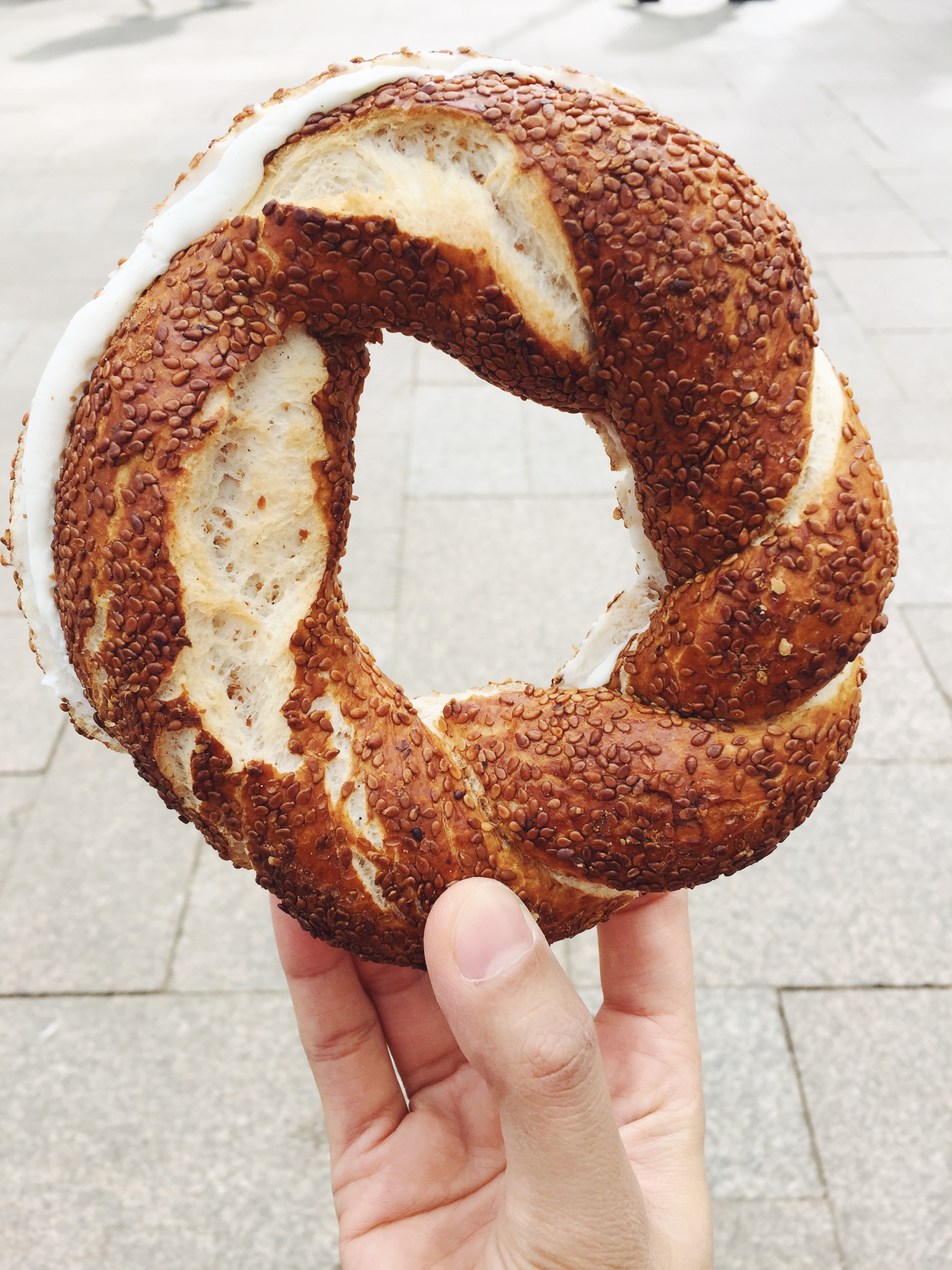
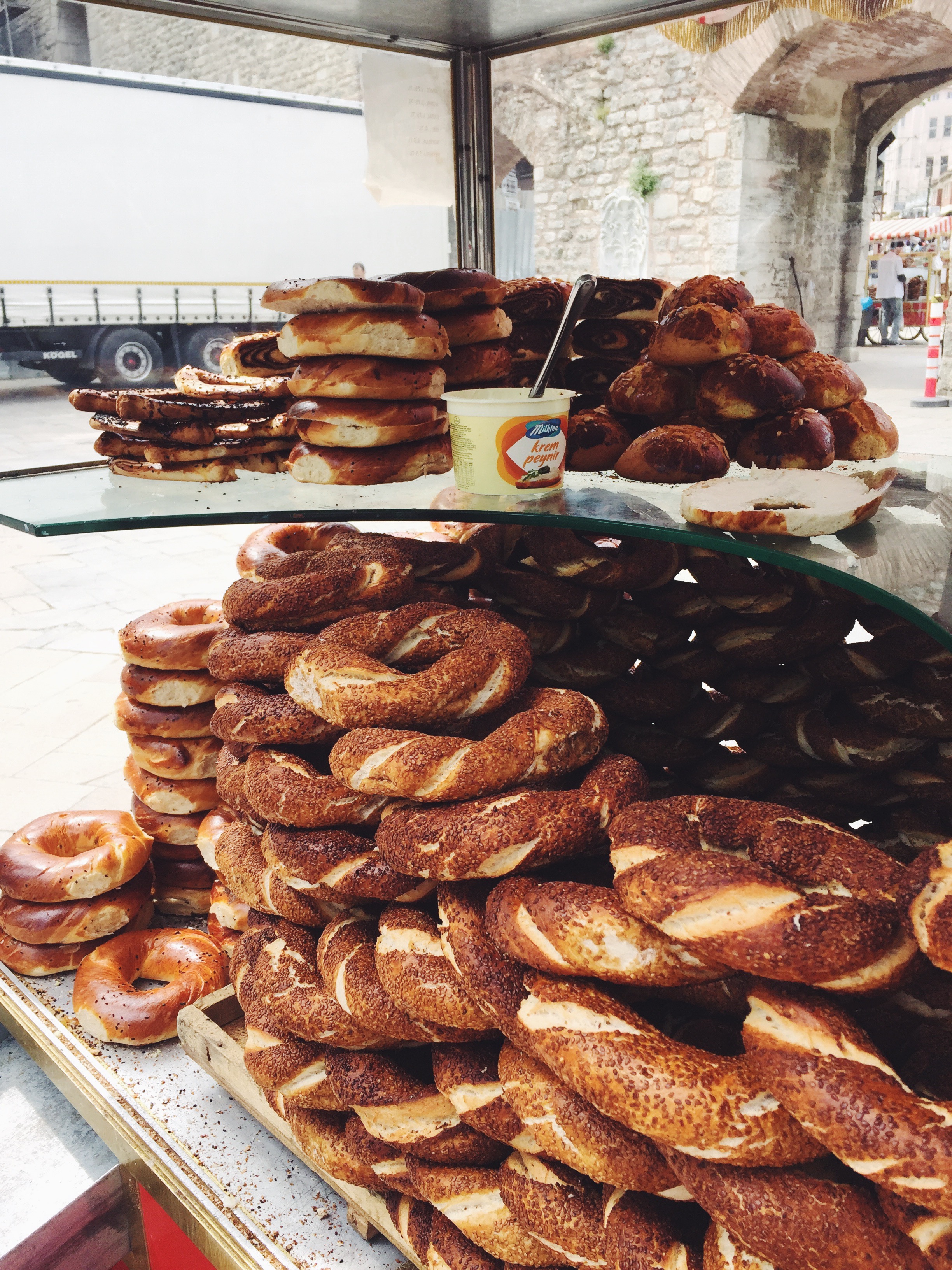
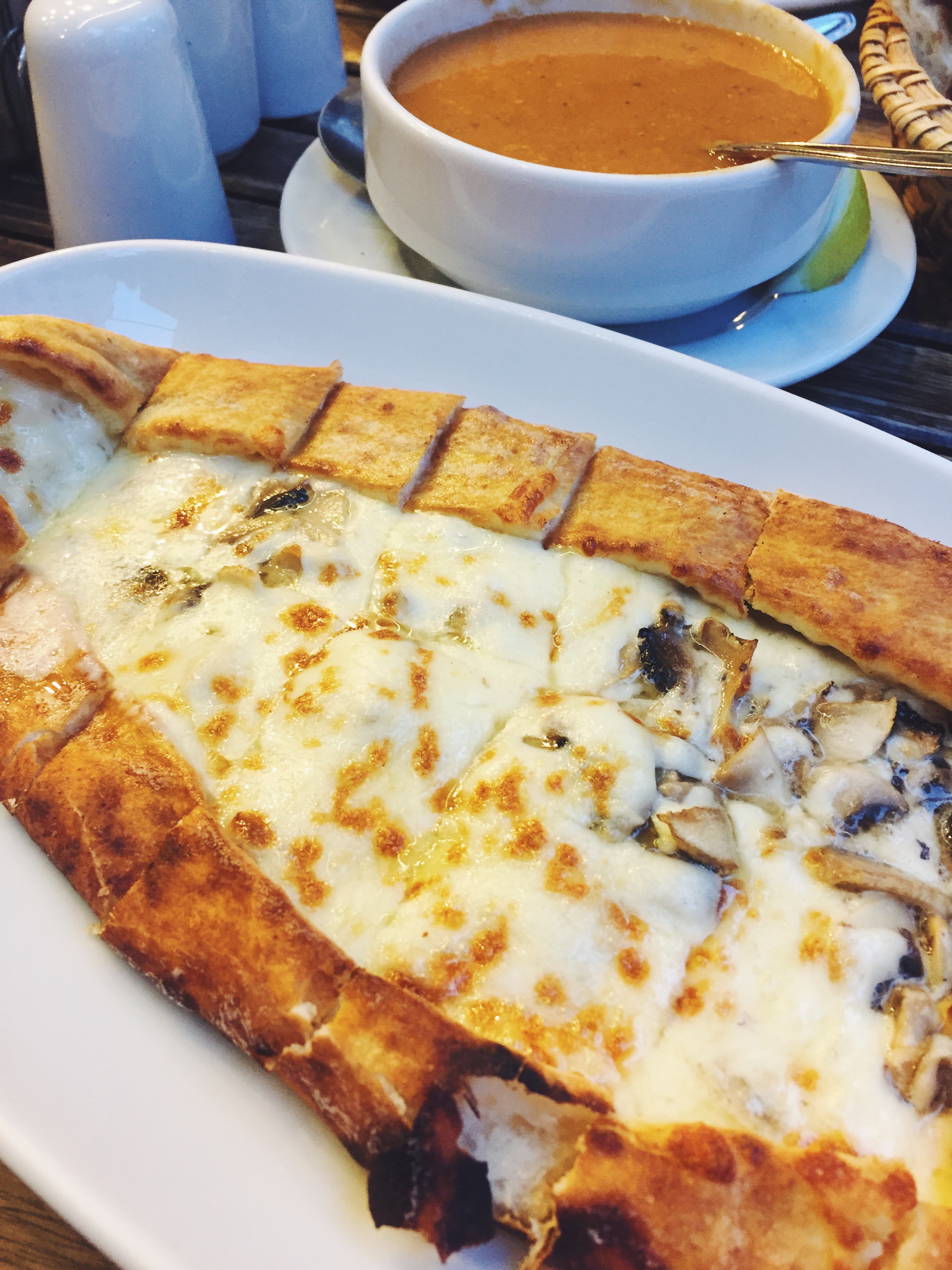
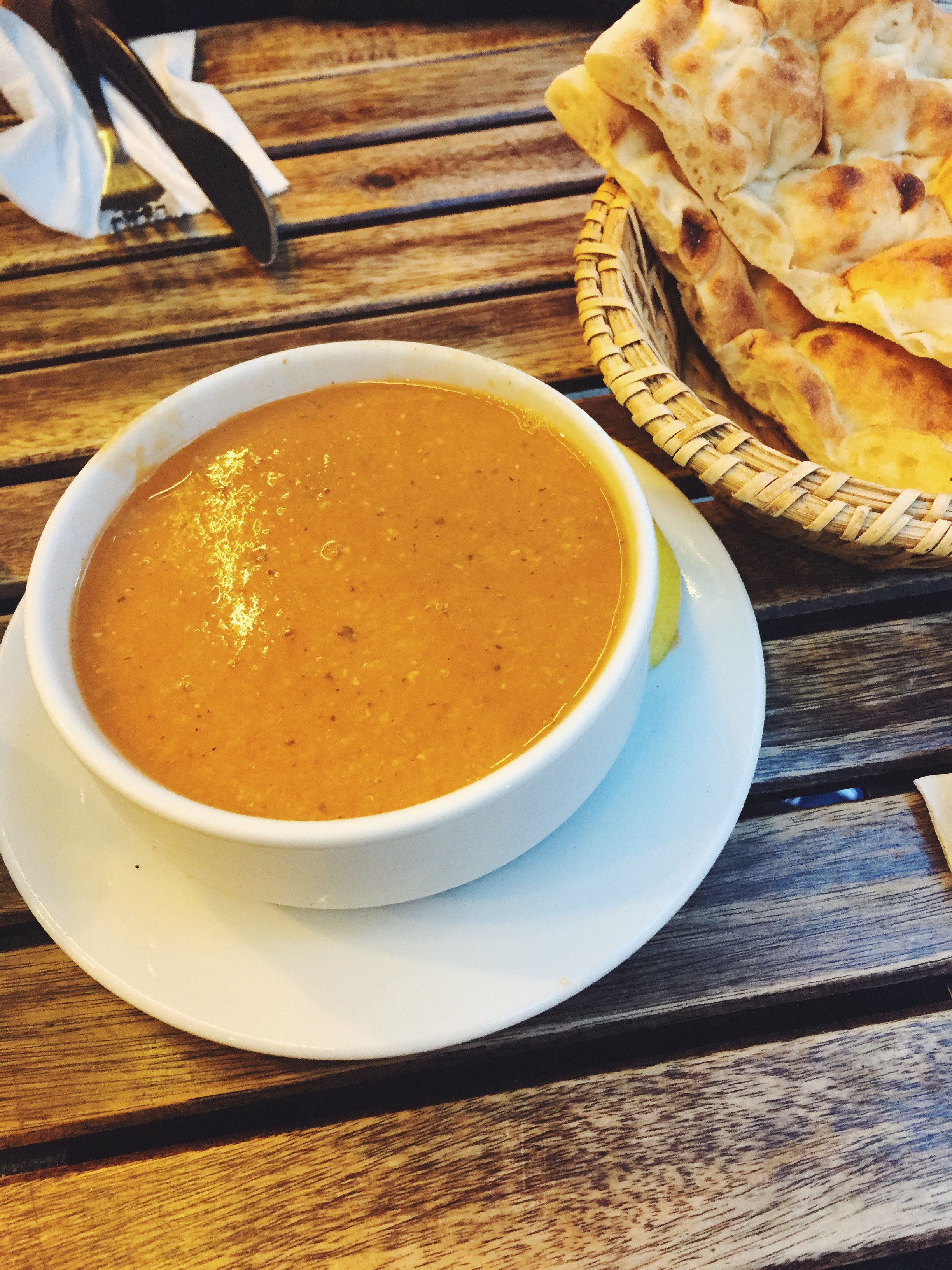
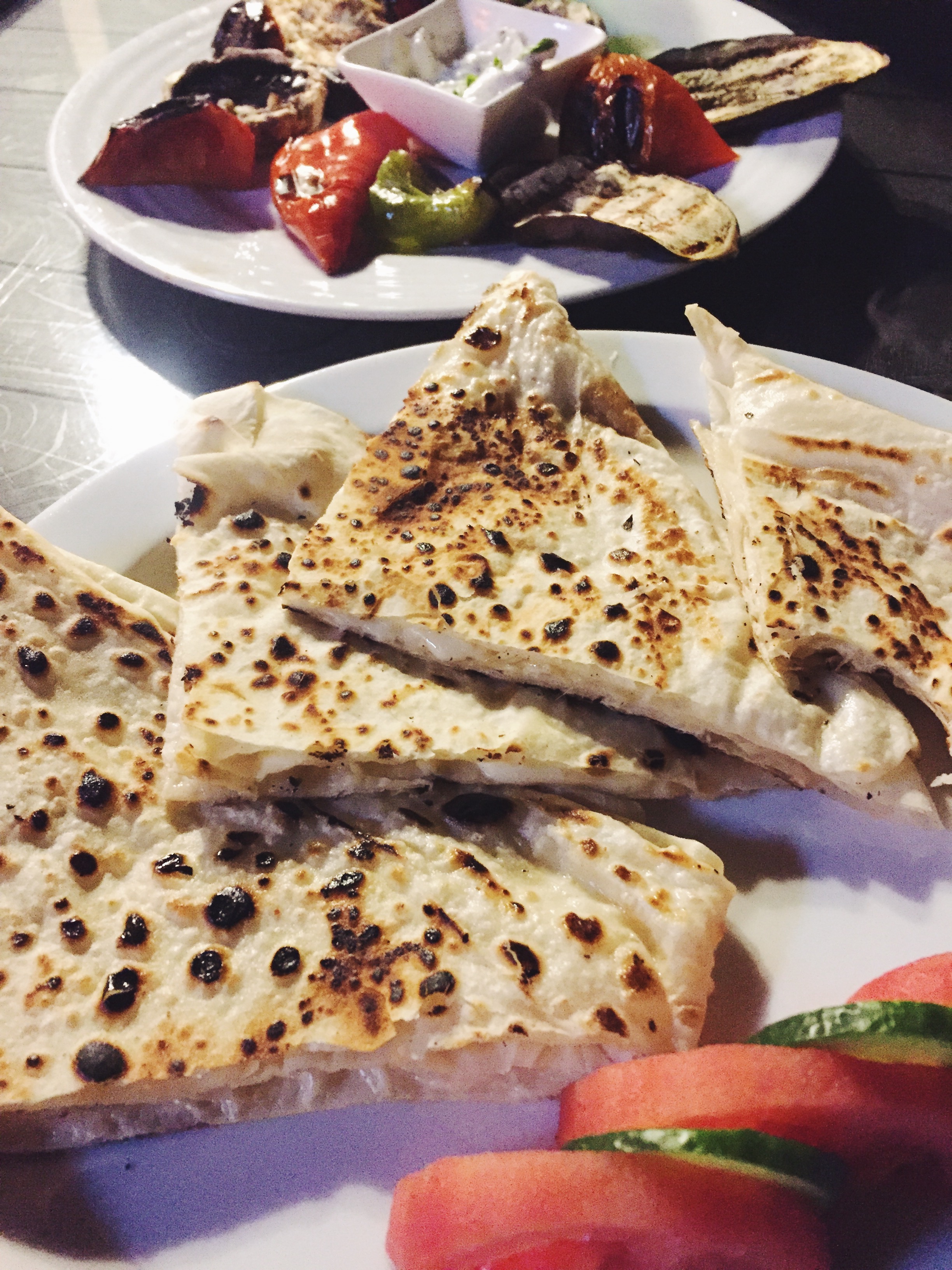
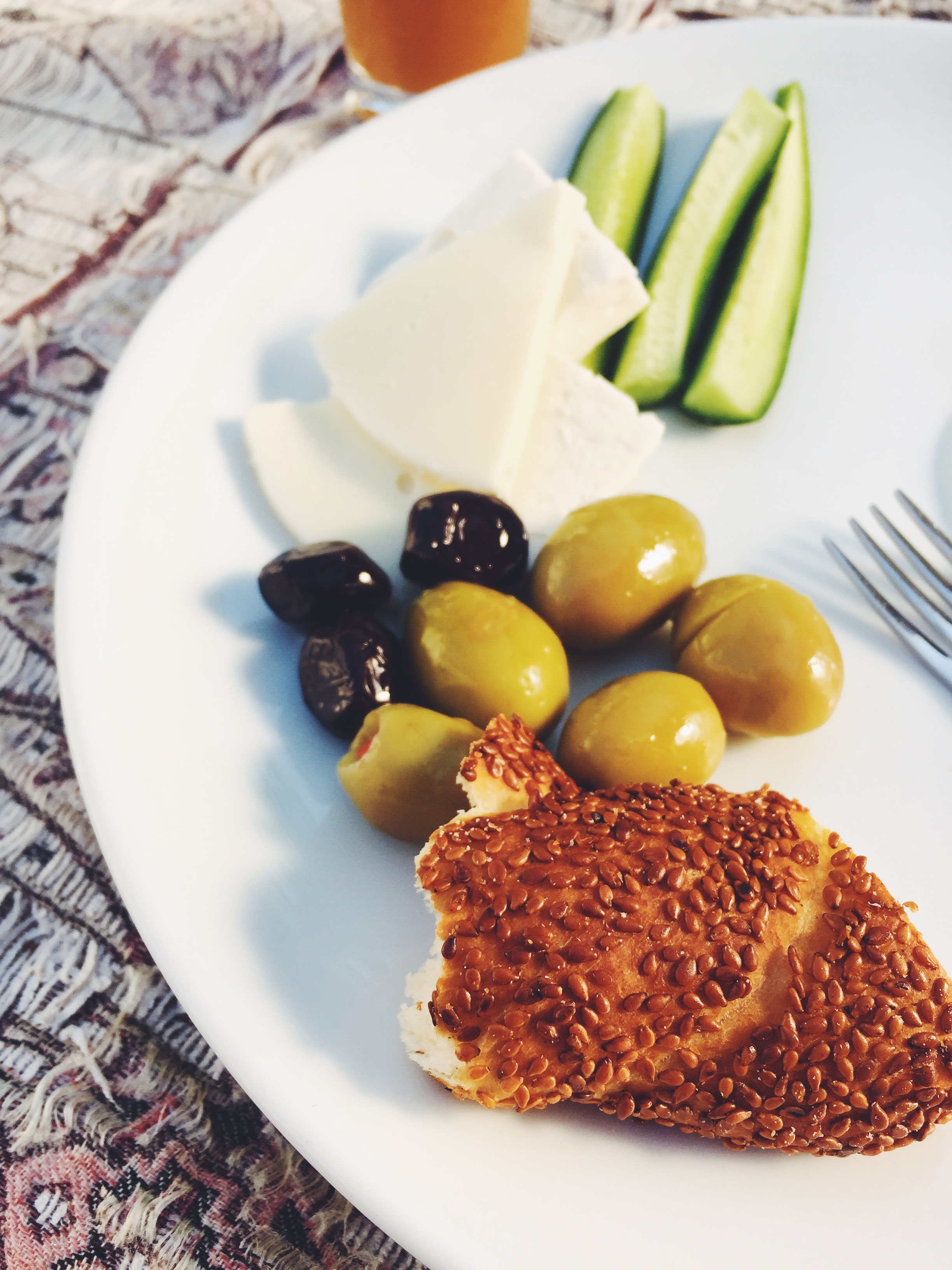
Turkish breakfasts are often cold, served with fresh cheese and olives which I gorged on because they were just so good!! A couple of times we went out to cafes to get hot omlettes and fresh bread, so it makes a good change if you’re an egg-in-the-morning person like I am! I found Turkish tea and coffee to be a bit too strong for my taste, so I stuck with regular cappuccino and the Karakoy area has SO MANY cafes, you’ll get some great coffee, no matter which one you prefer. Turkish coffee is often served with Turkish Delight, the sweet, firm jelly-like sweet that you will find at every second shop!
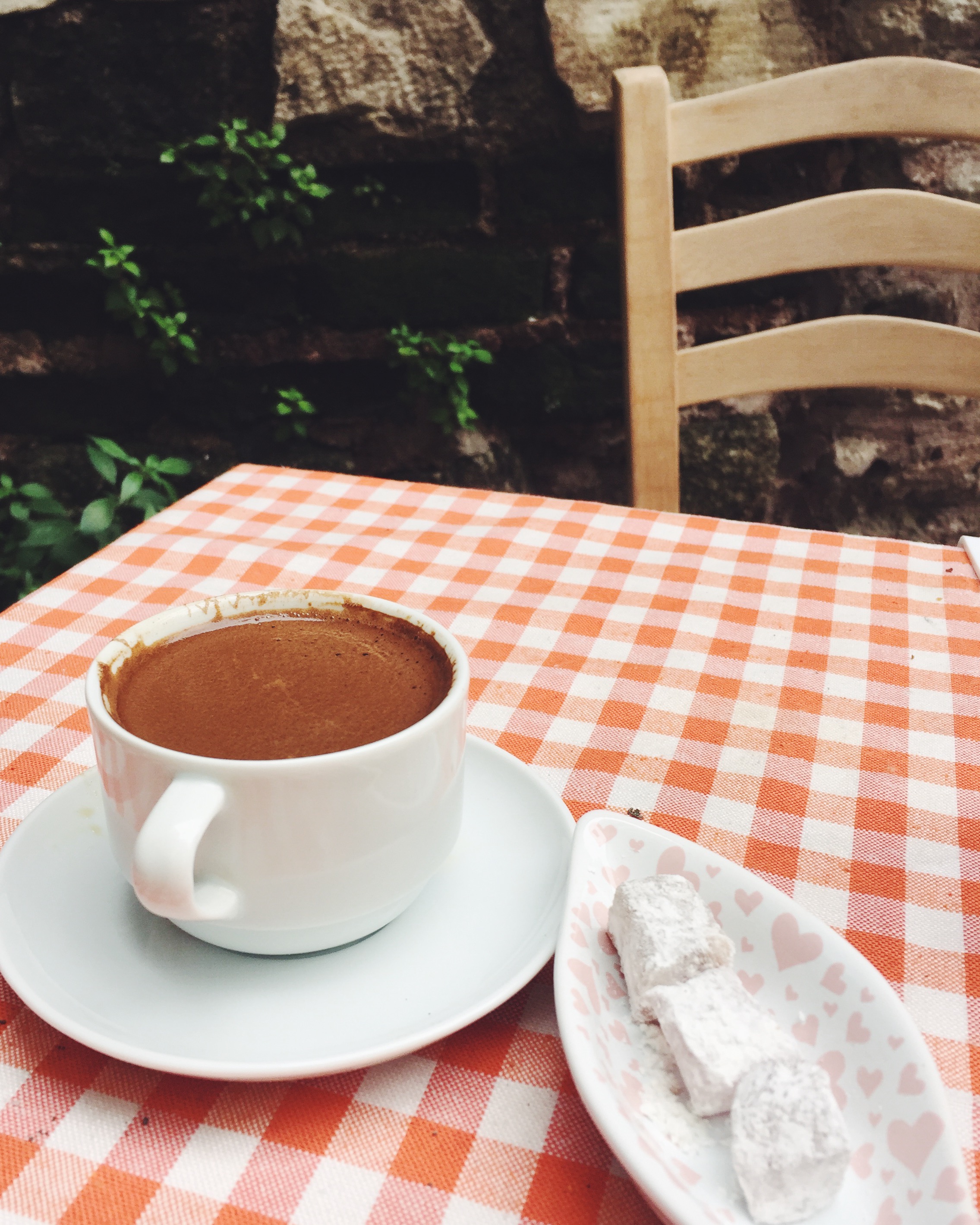
And speaking of sweets, it’s finally time to talk about baklava! I’m happy to say, the hype is real for a reason. Yes it’s very sweet and you can’t eat much at a time but it’s goooood. Flaky filo pastry stuffed with nuts, doused in syrup. I’m not even the biggest fan of walnuts and pistachios and I ate a TON of baklava in Turkey. Always make sure you buy sweets freshly packed from a sweet shop that makes all of it on the premises. The pre-packaged ones aren’t recommended because they don’t taste the way the fresh ones do, whether it’s baklava or Turkish Delight. We discovered Safa Sweets on Istiklal Street in Istanbul and it was just incredible, with also the nicest man who helped us choose what we wanted and answered all my questions super patiently. There is also Hafiz Mustafa which I found a bit overpriced, but has lots of branches and is more famous. The oldest sweet shop is Karaköy Güllüoğlu which I’m sure is very good, but by the time we got there, I was already hopped up on sugar! It’s more crowded and touristy than any other sweet shop, and we ended up just walking through it and heading back to Safa! We had some baklava packed up for us there and they made sure the boxes survive the flight back. Do not miss the walnut baklava (try the chocolate too), the cigar-shaped and not very sweet pistachio Pasa Sarmaşı (it was my unbelievable!!), the fried doughnut-like Tolumba which comes in an oblong shape and the very similar tasting circular sweet called Halka (see photos below). In other sweets, try the Turkish version of rice pudding, which is served cold and tastes like a vanilla custard, it’s yum! There’s also Kunefe, which is gooey cheese topped with sugar syrup-soaked Kadayif noodles. It wasn’t my first choice of dessert, but then again, I’m a little baklava-obsessed!
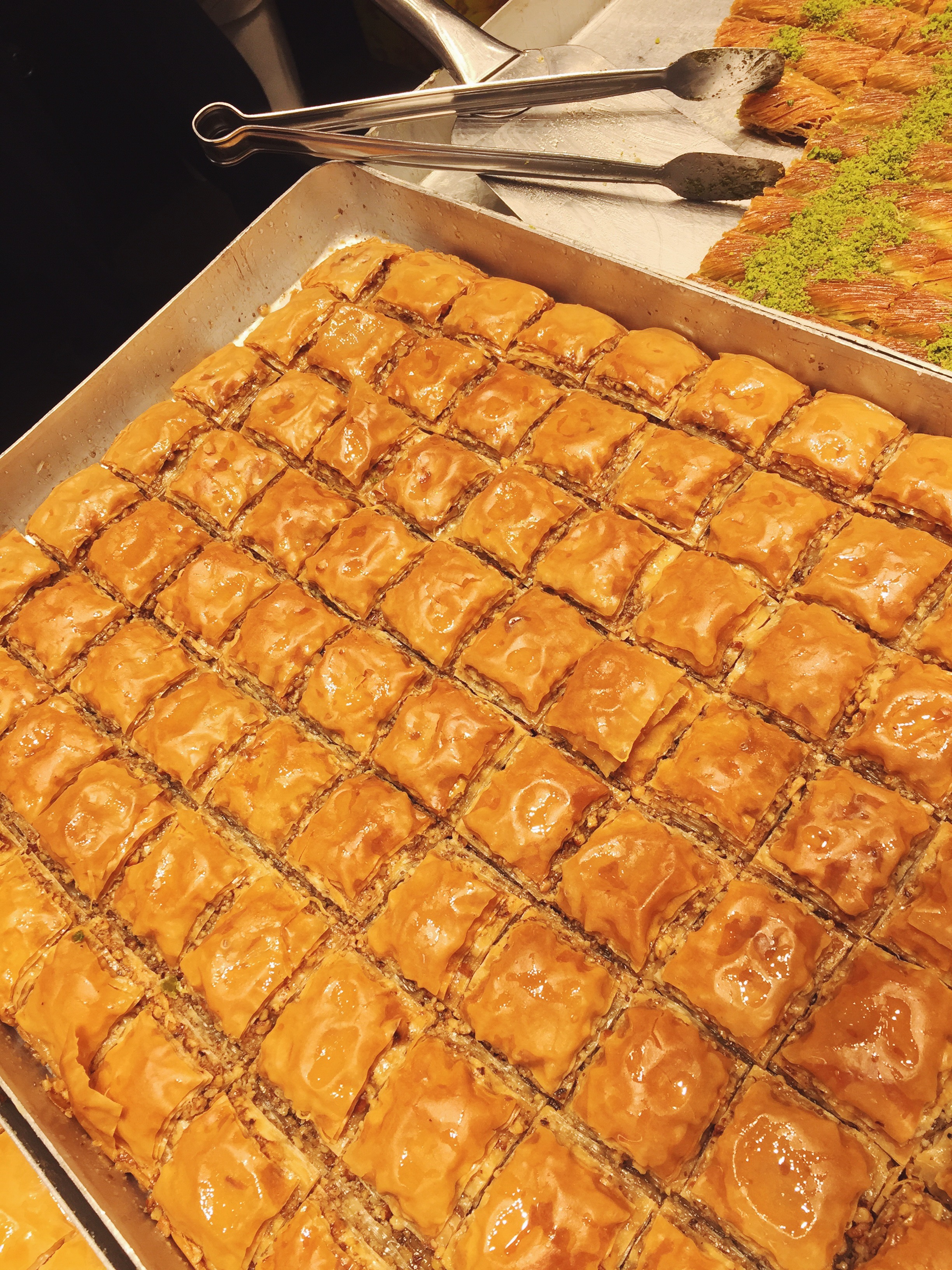
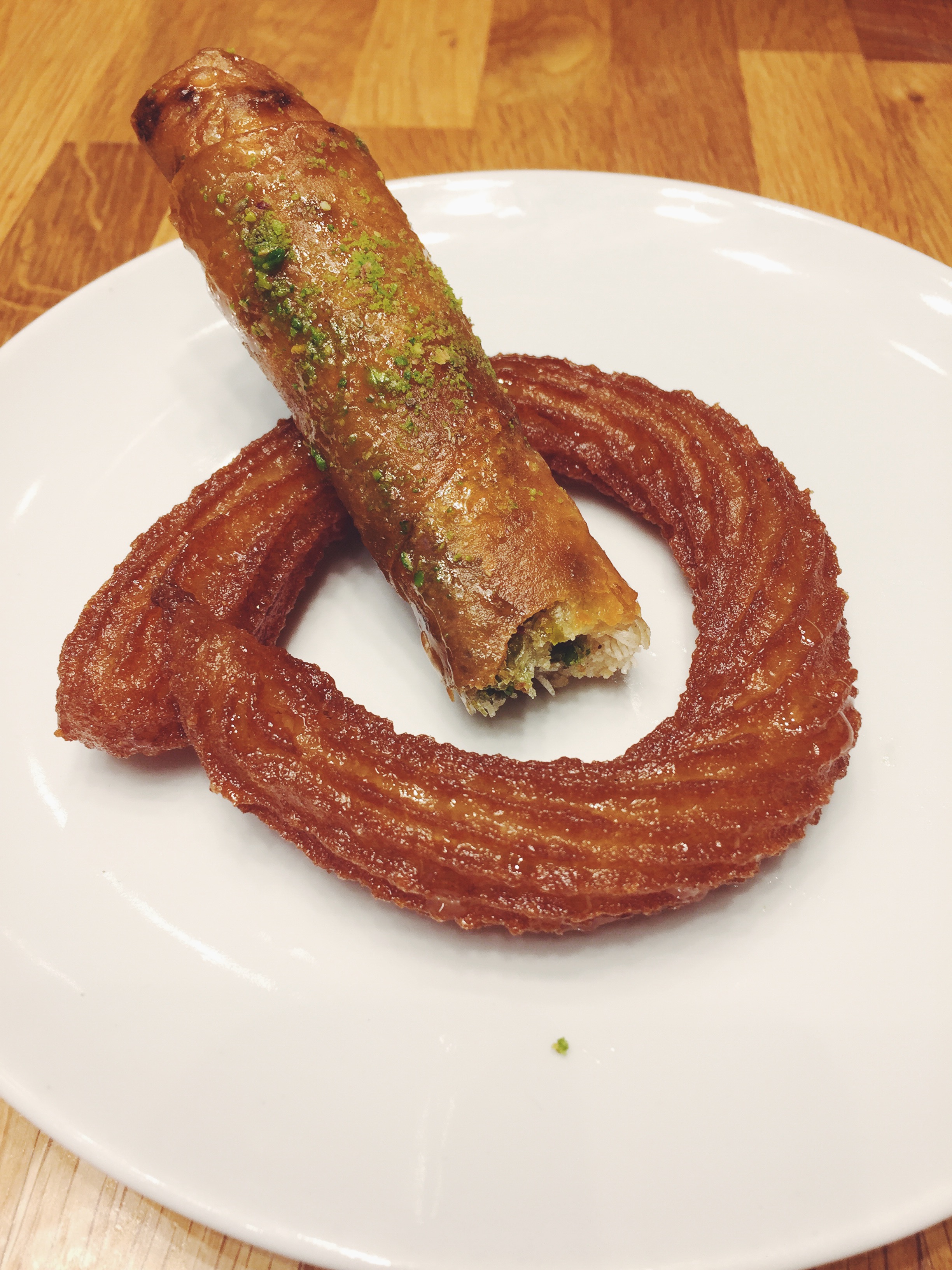
Istanbul has a lot of famous, pricier restaurants with lovely views but personally, I enjoyed eating more street food as we walked around. If you do want to try out a fancier restaurant, try Leb-i-Derya for some interesting vegetarian starters and pretty views of the Bosporous. We had a nice lunch at Parole on Istiklal Street as well. I’ve heard Ciya on the Asian side is known for it’s vegetarian food but we didn’t end up going there. In Cappadocia, we had a really nice dinner at Viewpoint where they drape blankets on you when the breeze gets a bit much! Also try local Cappadocian wines, they’re great! The Organic Cave Kitchen also has vegetarian options and nice views. They serve pottery kebab which is like steamed veggies with rice, but I preferred the other food options mentioned above. For more restaurant and food recommendations, check out this and this.
In terms of how expensive Turkey is, when we went, the Turkish Lira was about INR 12 so while it’s not super expensive to eat, shop and do some sightseeing, it’s not dirt cheap either. Street food is naturally more affordable (and sometimes better!) than eating at bigger restaurants, although it’s a good idea to do a bit of both. Most touristy places also have entry charges at about 60 Lira, except the Blue Mosque which is free. Shopping at places like Grand Bazaar is where you can do a bit of haggling to bring down prices. But overall, Turkey is much cheaper to holiday in than bigger European destinations.
There’s a bit of everything for everyone here and I would love to go back to Istanbul one day for sure! Till then, let me know if you’ve been to Turkey and I’d really like to hear what you thought about the place and what you ate, of course. If you’re planning a trip to Turkey, I hope you find this post useful!

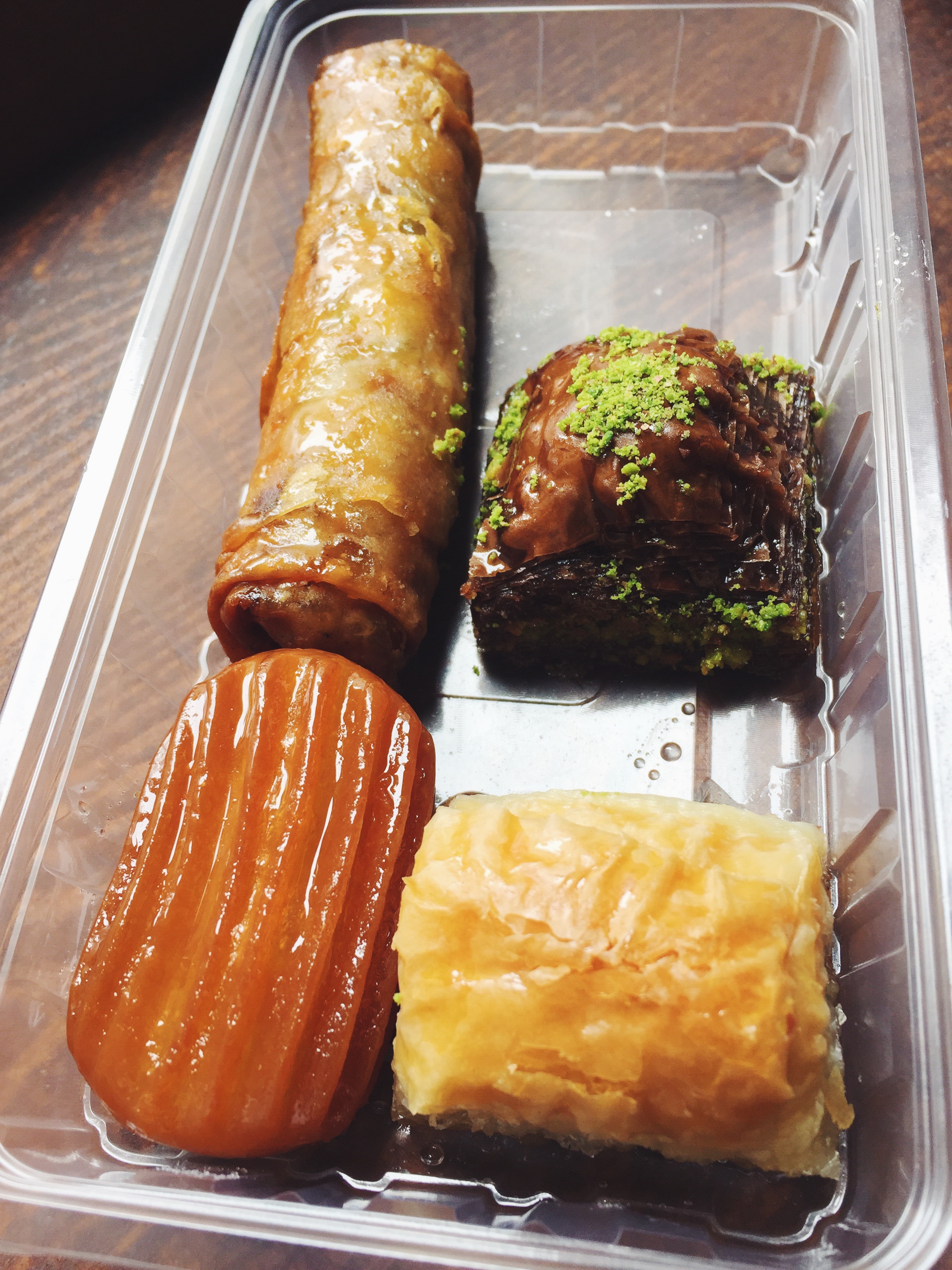
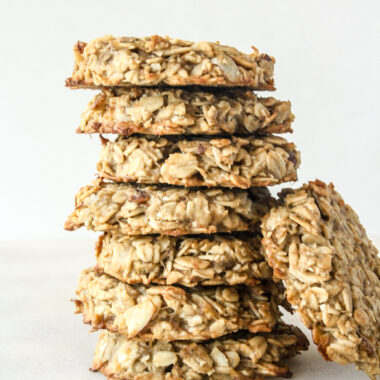





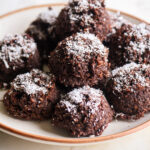






Loved this post! Took me back to my visit 5 years back, we decided then and there to come back, now can’t wait to go back!
So glad you enjoyed this post 🙂 it’s truly such a lovely place !
You are just awesome Gayatri, for sharing so much…whether it’s your recipes or travel, we gain so much just reading your posts. Your post on Goa is still so vivid in my head, its as if we are transported to the places or food you write about.
Thank you so much your kind words !